In order to accelerate the development of prospective mathematical scientists, we have selected a series of textbooks one can study to reach expertise in mathematics and physics in the most efficient manner possible. Readers should aim to cover the stated curriculum in its entirety over the course of two to three years (but it will realistically take longer as you adapt to reading mathematics); it is comprehensive and essentially self-contained.
The task of discipline and finding the further structure is left to the reader, to put together the connections between these ideas. A guiding principle is to have a strong command of the fundamental areas of mathematics, and let physics inspire the further mathematical concepts. Mathematics clarifies physics, and physics gives life to mathematics.
Beyond Shilov’s book, this list assumes knowledge of basic mathematics, calculus in a single variable, and multiple variables. Another landmark book introducing a geometric perspective on ordinary differential equations by Vladimir Arnold can be found here.
Fundamental Ideas in Mechanics, Fields, and Geometry:
Georgiy Shilov – Linear Algebra
This inexpensive text covers the basics of linear algebra and serves as an excellent introduction to proof-based mathematics. This is an essential read for scientists of all disciplines; the applications are immediate and uniform across the sciences.
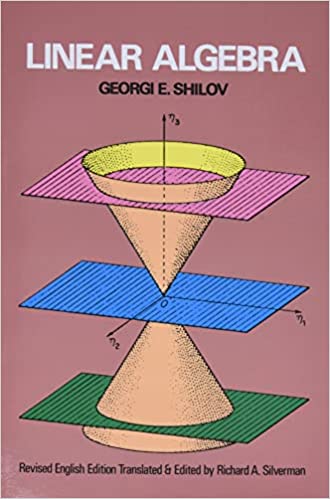
Table of Contents





Lev Landau, Evgeny Lifshitz – Mechanics
This book is a true first introduction to physics, much of classical mechanics coursework does not introduce physical principles to instead focus on calculus problems. A variety of methods are introduced under the common theme of geometric/calculus-driven dynamics in coordinate space. Beginning with how the unified principle of least action gives Newton’s laws as a consequence, the book proceeds to give powerful explicit methods of constructing mechanical systems; Following the foundational concepts of conservation laws, a cornucopia of topics: motion along a potential, collisions, oscillations, and rigid bodies. Finally, the second fundamental formulation of classical mechanics is given, Hamiltonian mechanics on position-momentum phase space. The two formalisms and the practice between give sufficient intuition to study and derive all of the rest of physics, especially General Relativity and Quantum Mechanics.
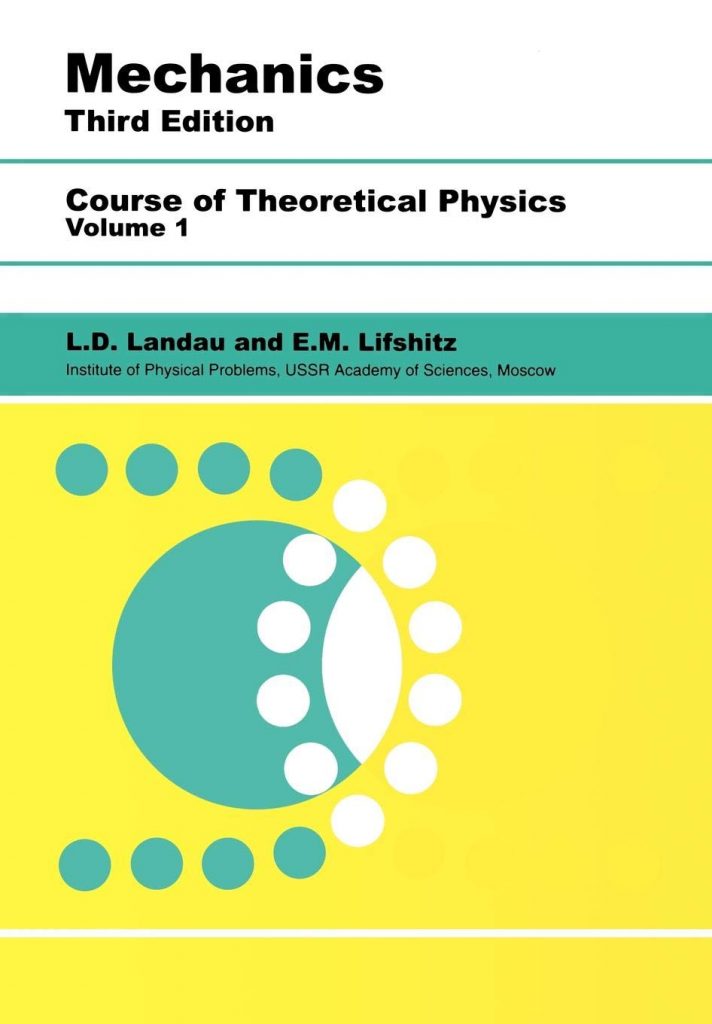
Table of Contents


Lev Landau, Evgeny Lifshitz – The Classical Theory of Fields
This volume on fields begins even easier than the mechanics text, so it is worth reading at least just the first chapter for a direct introduction to special relativity and how to treat quantities like velocity in this space-time setting. The calculus in this book is straightforward, the real takeaway is that there is geometrical thinking underneath the dynamics in physics that is elaborated on in differential and spin geometry texts. The focus in this book, given those geometrical tools as background (eg metric) fields, is to derive the form of electromagnetism and gravity in a non-coordinate-specific way and in curving space. A brief discussion on cosmology is at the end. The reader should thereafter be convinced that there is a need to acknowledge the geometric reality aside from our coordinate calculations.
Practically, the book gives a mathematical description of the topics between geometrical optics to full electrodynamics; On the one hand, leading to mathematical analogies with quantum mechanics, and on the other, electromagnetism can be continued in volume 8 for more electrical-engineering relevant topics.

Table of Contents




Lars Ahlfors – Complex Analysis
This entire book is a gem. Complex analysis is a basic topic every mathematical scientist should be familiar with; in particular the techniques of contour integration and residue calculus have widespread application, but every topic covered in this text has great general appeal.
Much of the form of basic topology is directly inspired by the historical developments of complex analysis, and complex numbers represent an important prototype for mathematical generalization.
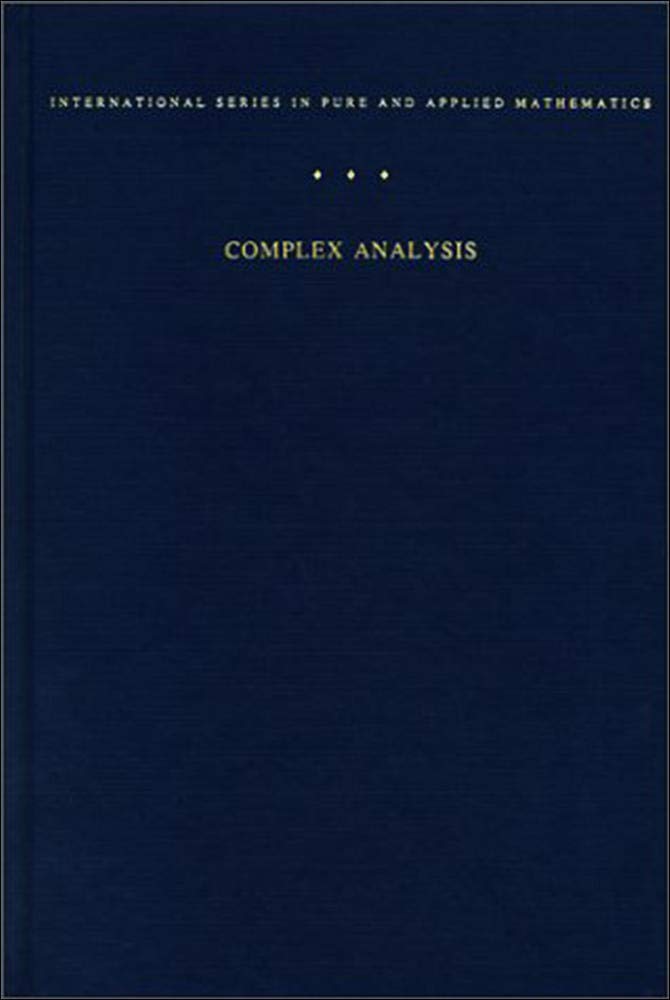
Table of Contents





Ronald Brown – Topology and Groupoids
A pdf is available on Brown’s website here. Topology is the study of continuous maps between spaces, but continues into algebraic topology where one finds algebraic incarnations of topological spaces. Standard texts overemphasize real analysis, but the applications of topology – especially differential topology, algebraic topology, and algebraic geometry – are much more substantial and important in physics and mathematics. Brown’s book is the only introductory book, so far, to the topic of groupoids in topology. Groupoids are algebraic structures resembling directed graphs that capture information about surfaces like points and loops. While he also develops the algebra of groupoids in analogy to topological spaces, Brown also thoroughly introduces the basic language of topology; This is a complete text.
For more on homology and surfaces, it is also helpful to read Ahlfors’ sequel book to complex analysis: Riemann Surfaces which is also at a basic level of topology. Primitive notions of homology are of course introduced in the previous complex analysis book, as they originate from the theory of complex contour integrals. Donaldson’s text on Riemann Surfaces is more modern, with topics such as theta functions, bundles, and the Gauss-Manin connection.
Brown’s approach is extremely fun, providing means for concrete representations and computations of topological properties of simple spaces given via examples. His sequel book Nonabelian Algebraic Topology significantly extends this material to higher dimensions, and leads to cutting edge topics in algebraic topology. In his book, you learn the construction of (strict) higher categories but also how to do explicit algebraic computations, extending Whitehead’s theory of relative homotopy groups usually seen in algebraic topology texts.
Groupoids appear in another way in differential geometry, via the orbit groupoid construction. Lie groupoids are an alternative to specify basic geometric structures (tangent spaces, connections) and a basic introduction to this is in Kirill Mackenzie’s book here and another book of his on the general theory of Lie groupoids here.
In combination with the symbolic methods of calculus, topology makes introductory real analysis mostly redundant. The formalism of studying maps between distinguished subsets of a set rather than just the elements is general enough to work in both smooth differential and physics settings as well as purely algebraic settings of Galois theory and abstract algebraic geometry. The need for topology is apparent when one tries to quantify the notion of continuity of a function, the relationship of convergence to boundedness, and the notion of convergence in a space of functions.
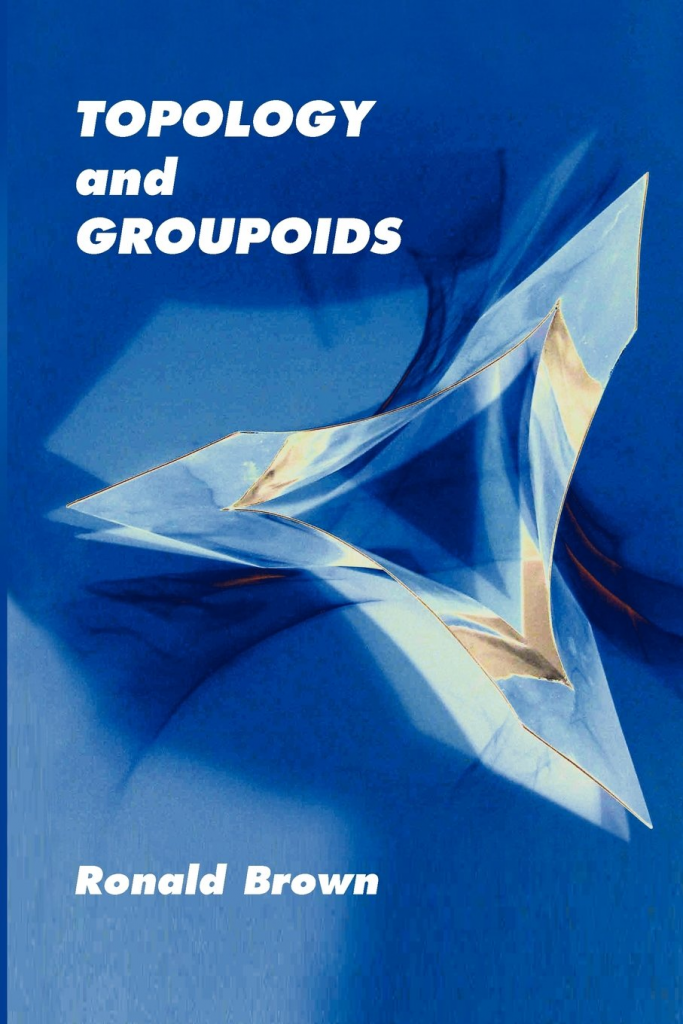
Table of Contents




Shlomo Sternberg – Lectures on Differential Geometry
Differential geometry is a general and powerful psychological aid to not only physics in curved space, but calculus in flat space with arbitrary curving coordinates. Its utility is apparent during Landau 2, when justifying the formulae for changes of coordinates of tensor quantities. The first chapter serves as an advanced mini course on multilinear algebra, extending the material from Shilov. The remainder of the book constructs geometric quantities from space rather than numerically, and produces a theory of integration, differentiation, optimization which re-instantiate into familiar calculus when represented locally with coordinates. The material then shifts to consider lie groups and their basic uses for spatial structure and calculus, to be regarded as the polytopes of the continuous differentiable world.
Vladimir Arnol’d also has a book on symplectic geometry, continuing the classical mechanics perspective here.
Another book of his applying differential geometric methods to fluid mechanics is here.
Hassler Whitney, the axiomatizer of manifolds, has a good book focused on analytical aspects of Geometric Integration Theory.
Differential geometry’s focus in this list is towards topology and field theory, which the following texts build up to. Two other books of Sternberg that emphasize physical applications are his Curvature in Mathematics and Physics which continues nicely from here in topics related to GR and gauge theory, and Group Theory and Physics which being adjacent to gauge theory, covers representation theoretical and quantum mechanical aspects like the classification of spins/particles. These topics appear multiple times throughout our list, notably in Kobayashi-Nomizu/Atiyah YM and Woit/Weinberg respectively, but Sternberg’s emphasis on physics in combination with the investment into the language/his books may make them worthwhile where you are.

Table of Contents



Peter Olver – Applications of Lie Groups to Differential Equations
Typical texts on ordinary and partial differential equations focus on analytic methods, which may be covered as early as during calculus courses. What is missing from those courses, despite analysis being useful, is the more fundamental perspective of differential equations being entirely geometric entities, determining the shapes of solution functions and the equations themselves being determined – as shown in this book – by abstract symmetries. Perspective aside, this method of studying differential equations is precisely how Sophus Lie came up with Lie Groups, how Noether’s theorem was proven, how all physics is specified by symmetry, and gives powerful insight into how we construct new differential equations in practice.
Analytical methods in partial differential equations are largely subsumed by the study of the Fourier Transform on generalized functions (Harmonic Analysis) and Green’s Functions/Propagators/Fundamental Solutions – which are reviewed thoroughly in the series below by Gel’fand and Shilov and appear implicitly throughout physics. Additionally, Olver has another introductory PDEs book reviewing these ideas.
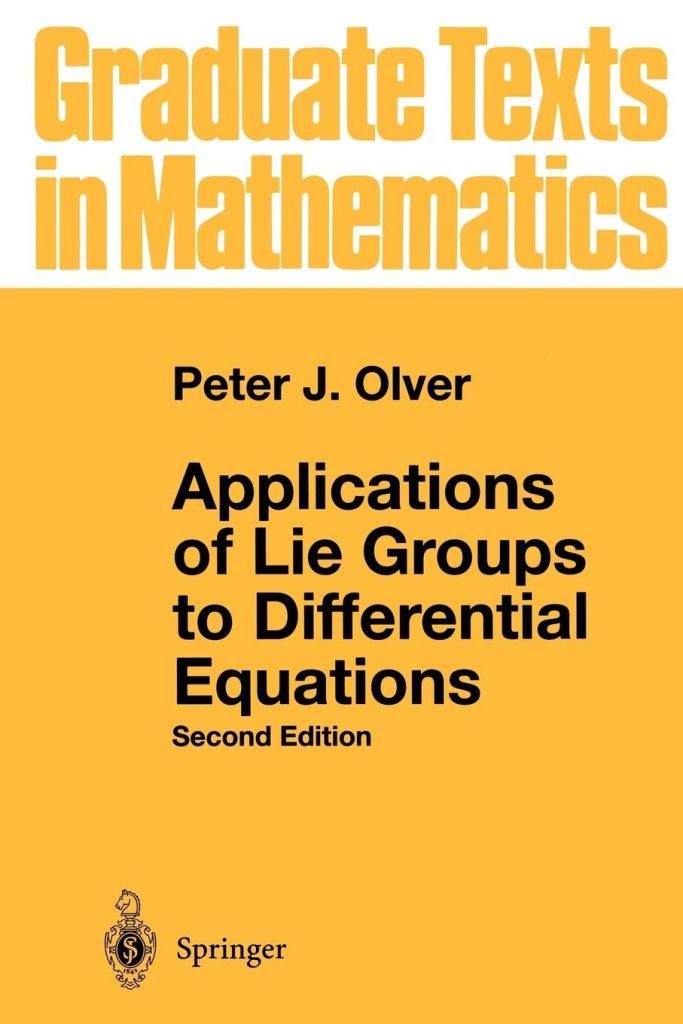
Table of Contents





Raoul Bott, Loring Tu – Differential Forms in Algebraic Topology
A famously lucid introduction to cohomology. While algebraic topology texts work towards or starting with the algebraic theory of functors and natural transformations from spaces to algebraic categories, it is the opinion of the creators of the fast track that a more relevant introduction to wider practices of science use calculus. The machinery of differential forms which arises from electromagnetism and integration in general is a symbolic and quantitative aid to integrate along domains of arbitrary dimensions (paths, surfaces, volumes, etc.) and simultaneously keep track of orientation along these structures in the process. It is a realization of electromagnetism that the domain of definition of these vector field quantities determines the possible smooth vector fields that can even exist. This has a few consequences, determining “electric charge” of a field, the structure of space via the Euler characteristic, and homotopy which are all explored in the text. Abstract algebraic topology texts are significantly more approachable following this book.
You may wish to reference Chapter 8 of Theodore Shifrin – Multivariable Mathematics for integration of differential forms and the generalized Stokes’ theorem* before starting this text.
In a similar spirt of differential forms, the book on Rational Homotopy Theory by Griffiths and Morgan continues these topics.
De Rham’s theorem comparing singular/locally constant sheaf cohomology to smooth differential form De Rham cohomology is a fundamental result of the first part of the book. If given a less abstract focus, the simplices approximating a manifold via the nerve of an open cover are treated like cells/domains of a finite element method, De Rham’s theorem becomes a statement about numerical differential equations. A difference equation of cochains numerically approximates general differential forms with given differential equations and equivalently computes the cohomology of the manifold. This directly applies to differential equations in areas of physics where the equation comes from a geometrical structure (electromagnetism, elasticity in solids, fluid mechanics). A book outlining the finite element and interpolation side of the theory is here. The relevant function space and operator background comes with studying quantum mechanics and the distribution theory in the volumes by Gel’fand later in this list.
*either in Apostol Calculus, Sternberg diff geo, or Sternberg Advanced Calculus
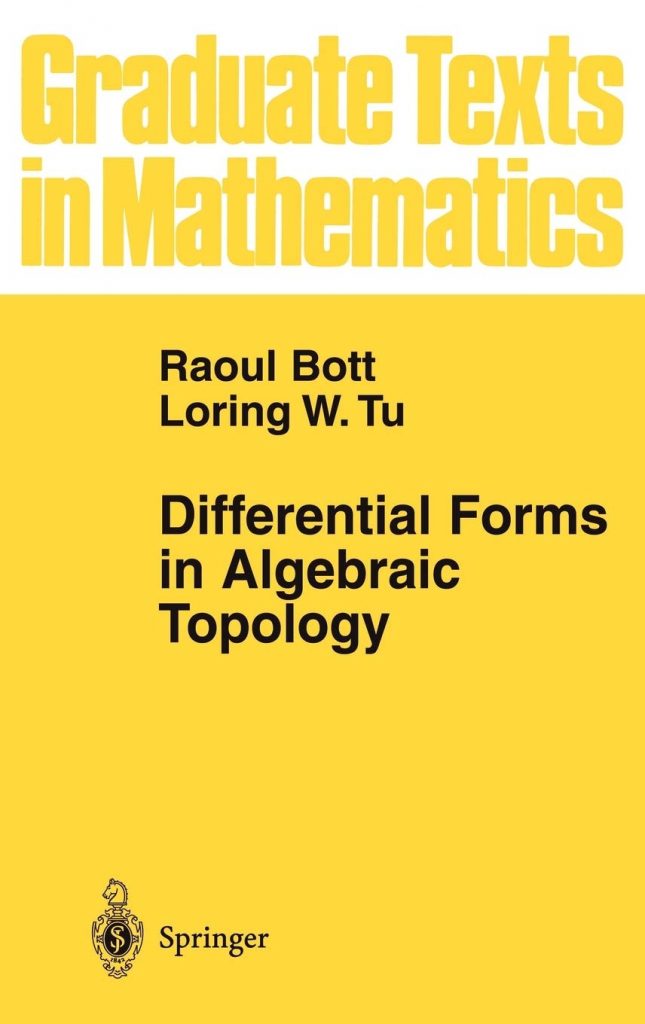
Table of Contents




Quantum Theory and Statistical Physics:
Lev Landau, Evgeny Lifshitz – Quantum Mechanics: Non-Relativistic Theory
Quantum mechanics, despite being treated like a forbidding and impossible to understand subject, is simply an application of the classical rules of dynamics to vectors in a complex vector space instead of to positions in a generalized coordinate space. With this perspective, it is easy to see how most of the formalism is justified, and the relationship to classical position comes about by these vectors being representable as functions over classical position space. Being a practical text, you learn how to treat orthogonality in these vector spaces by means of integration, construct simple systems along with other classical mechanics analogues, the structure of atoms and molecules, and computational aspects unique to the quantum theory like perturbations and symmetry group representations.
What is difficult is deriving the precise relationship to classical mechanics, which is explored in Woit, Geometric Quantization, and becomes a part of the background for later volumes in the fast track. Notably an exposition of the central idea of “decoherence” is located in DeWitt’s books and in this Nima Arkani-Hamed video. It shows how in a pure quantum mechanics setting one can get the appearance of sharp classical behavior.
Mathematical aspects of the theory such as the infinite dimensional version of the spectral theorem, Fourier transforms and harmonic analysis, the meaning of generalized eigenvectors, and when operators have “components” akin to matrices in finite dimensions is indicated, but further explored in the texts on generalized functions by Gel’fand and Shilov.
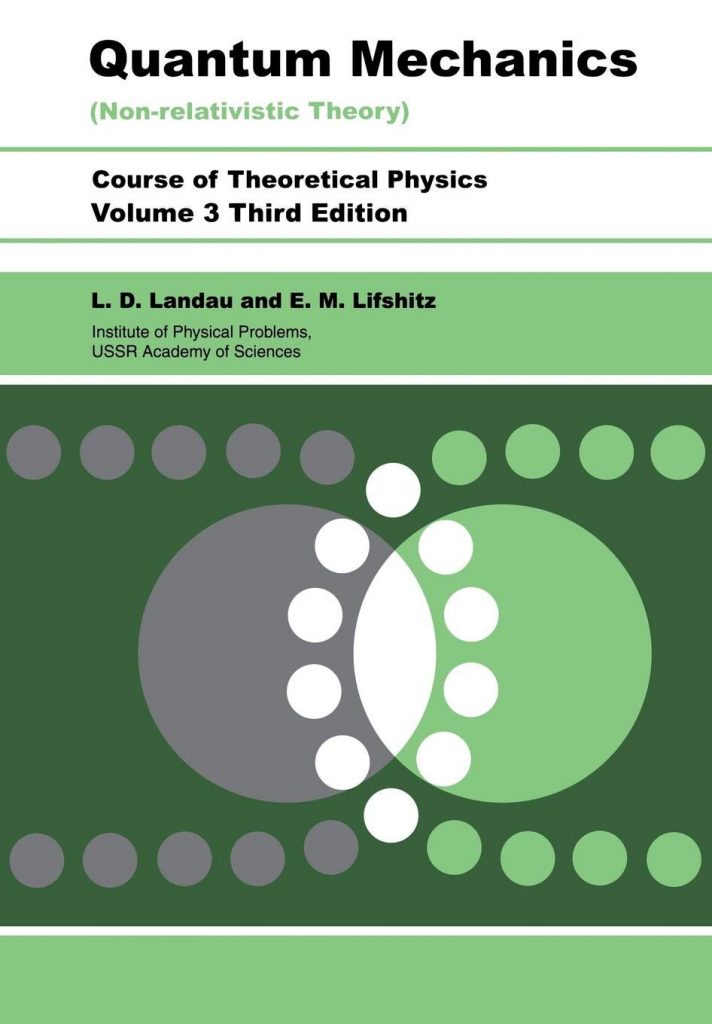
Table of Contents





Peter Woit – Quantum Theory, Groups and Representations
Much of this book seems redundant at a surface level to the previous representation theory material, but it is not in that the presentation is in the context of the structure of quantum mechanical systems and objects. By the end, the discussion of finite-volume cutoffs, Bargmann-Fock quantization, complex structures, infinite dimensional phase spaces should make Landau 4 (quantum electrodynamics) immediately accessible. The notion of a particle itself in quantum theory is representation-theoretic, so while reading Weinberg’s texts on Quantum Field Theory, this will be a helpful transition text as well as to understand what quantum mechanics is geometrically in general. Some lecture notes detailing second quantization and basic QFT at the same level are located here.
Because of the basic matrix-focused presentation, general forms of topics such as symplectic geometry, geometric quantization, spinors, and classical field theory (per Witten et al) are all foreshadowed.

Table of Contents












Israel Gel’fand, Naum Vilenkin – Generalized Functions 4: Applications of Harmonic Analysis
Following the invention of Quantum Mechanics, Gel’fand and Shilov initiated this comprehensive series on generalized functions to make mathematical sense of the theory. Volume 4 is on this list with particular relevance to quantum mechanics – the spectra of self-adjoint operators, nuclear spaces, unitary representations – however, all volumes are relevant and interesting. If any notions of delta functions, the space of operators and their group representations, or continuous spectra have seemed imprecise previously, they are all laid out definitively here. Intuitively, the notions of distribution theory are more like the basis/eigenvectors we work with in quantum mechanics and later quantum field theory – but formally equivalent to the corresponding measure theory. We consider this series essential for mathematical background whenever you need distributions in physics and differential geometry.
Volume 1 introduces basic operations on generalized functions: support, integration, Fourier transforms, how to define them in higher dimensions.
Volume 2 introduces “spaces of type S” now commonly known as Schwartz spaces which may be useful in proving analytical theorems in quantum mechanics, along with a quick summary of topological vector spaces.
Volume 3 applies generalized functions to differential equations, a common tool, but the special focus here allows for more depth e.g. in the Cauchy problem.
Volume 5 continues 4, with more geometry and function spaces on lie groups, hyperbolic geometry, symmetric spaces, and representation theory.
Volume 6 is the number theoretic analogue of 5, leading to topics such as adeles, automorphic forms, and zeta functions – whose close analogies to Quantum Mechanics are still inspirations to modern research.
Naum Vilenkin has also written a short series on the derivation of special functions from unitary representation theory. Further analysis of function spaces and partial differential operators can be explored in the series by Lars Hörmander.
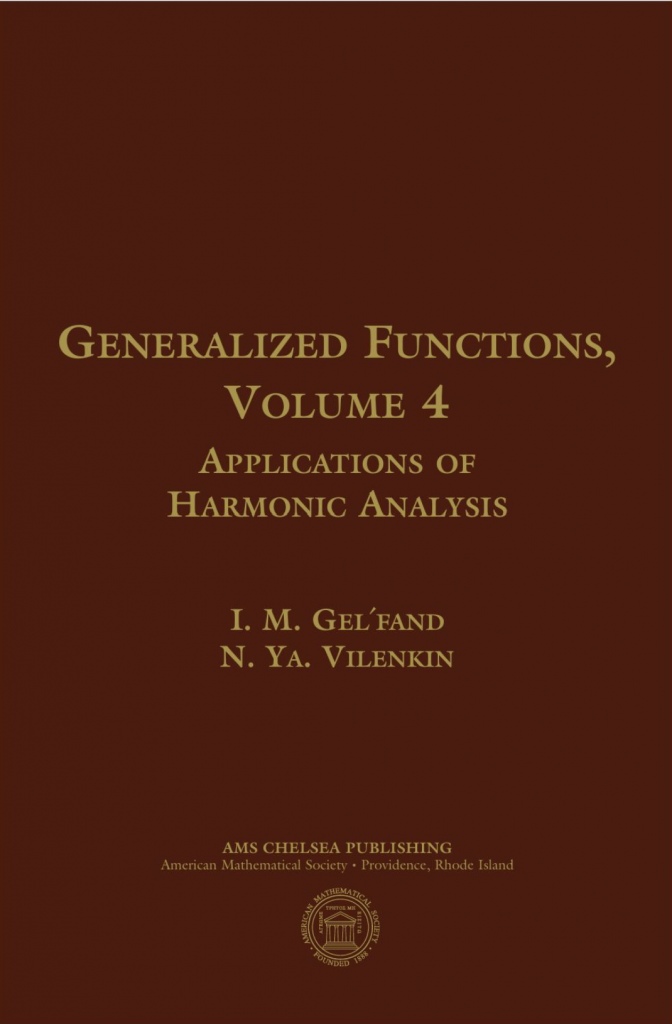
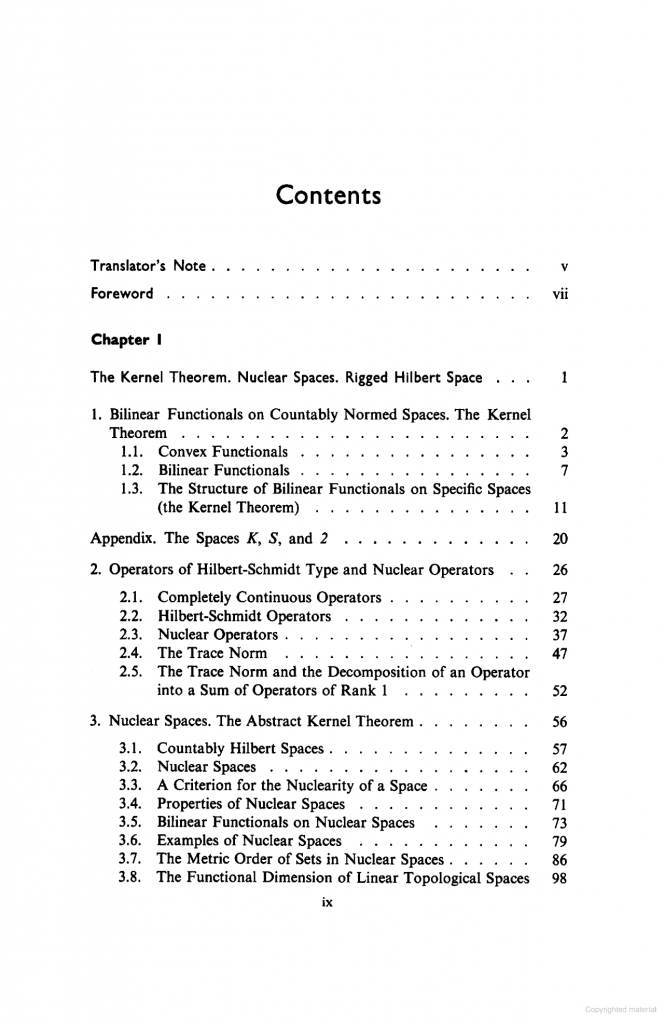
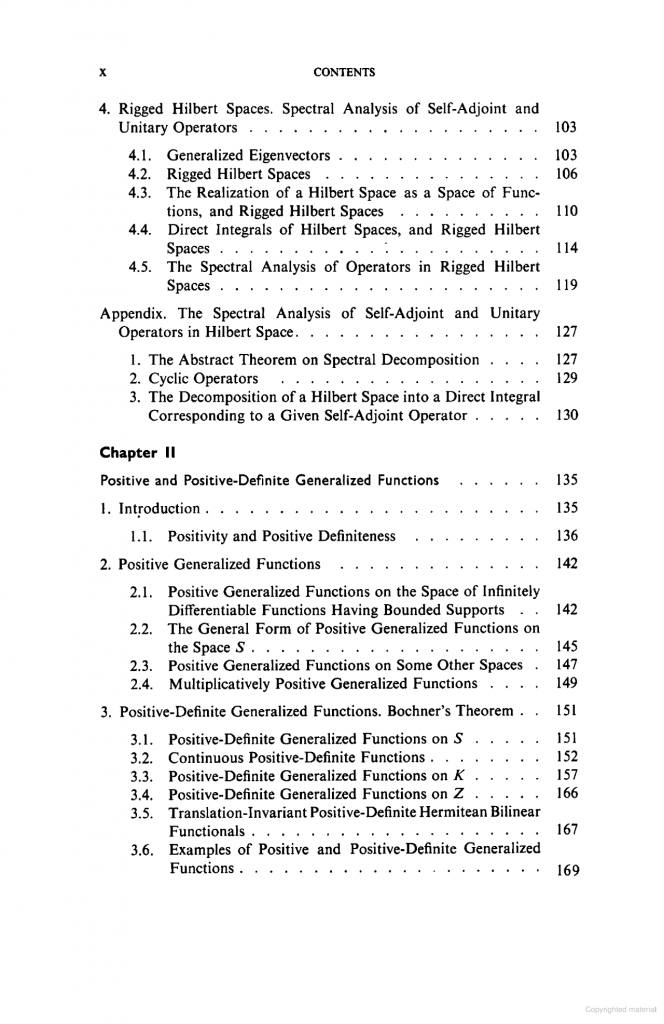
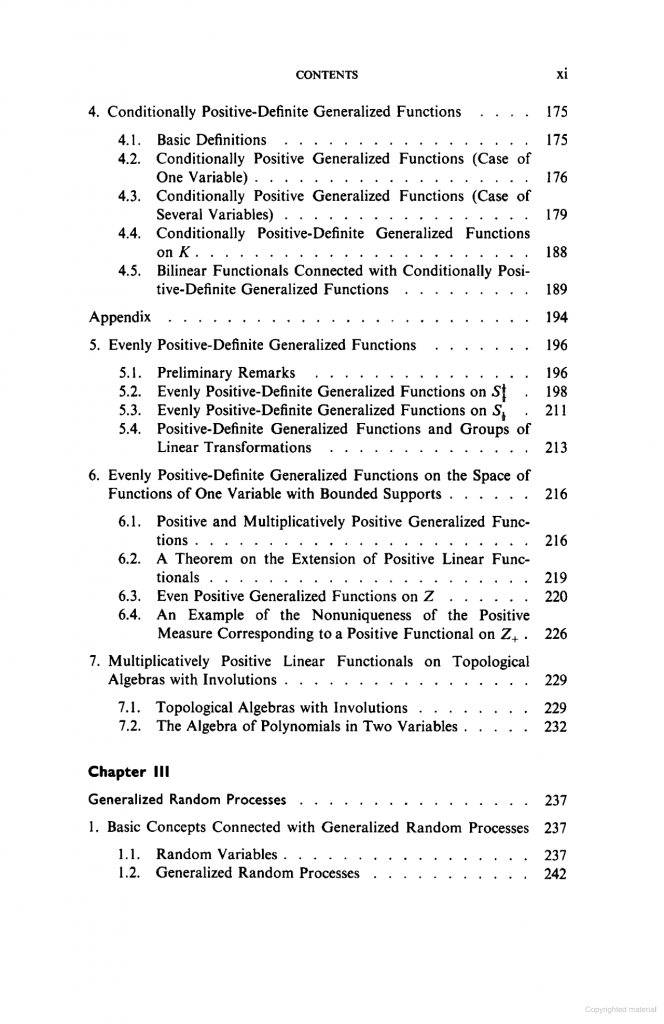
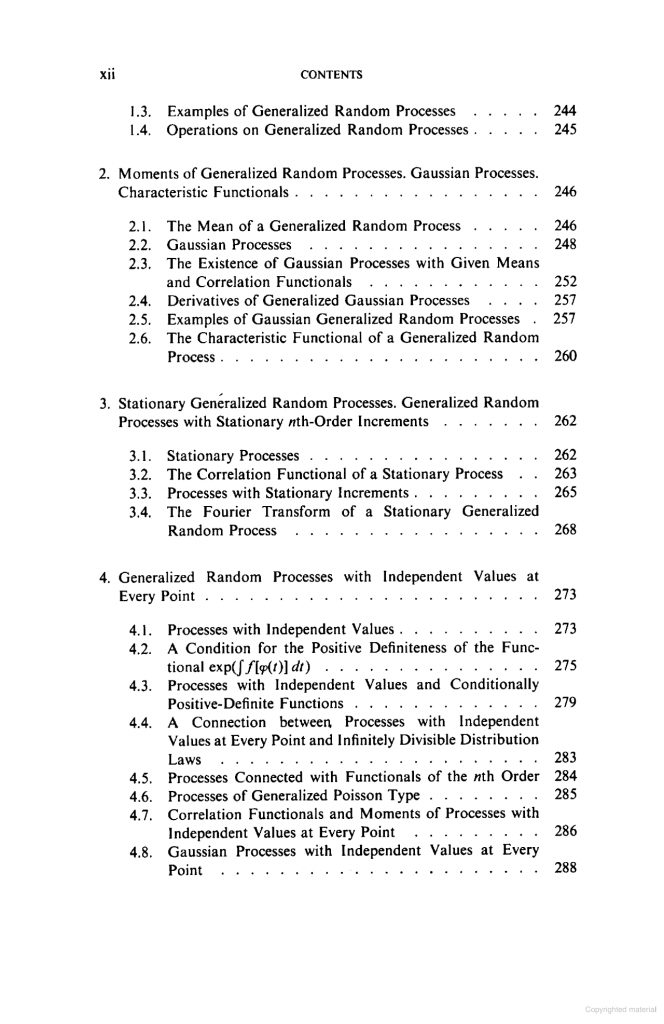
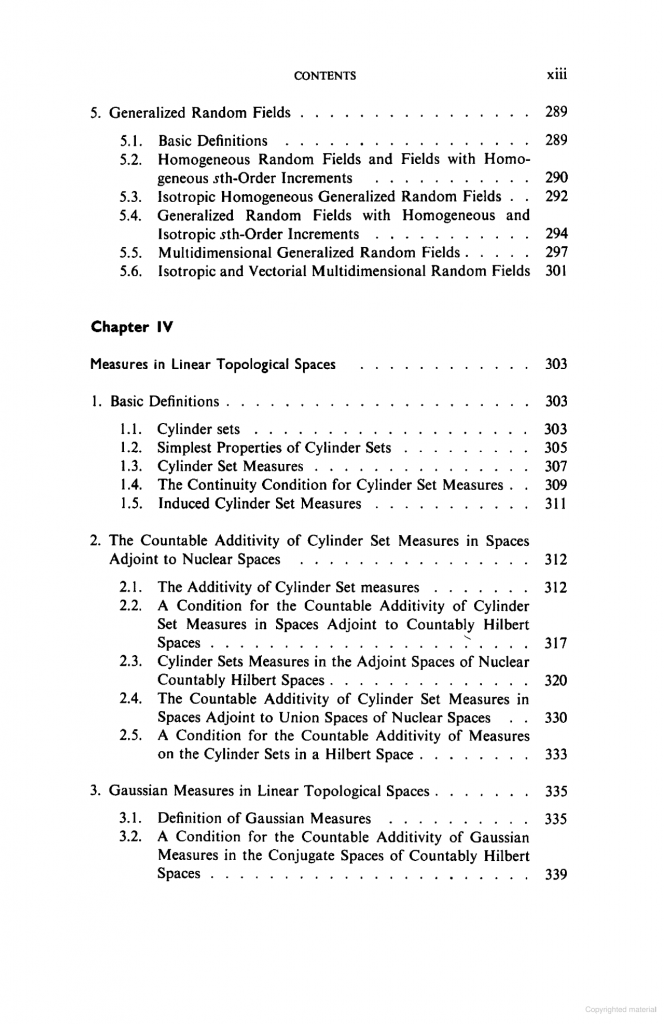
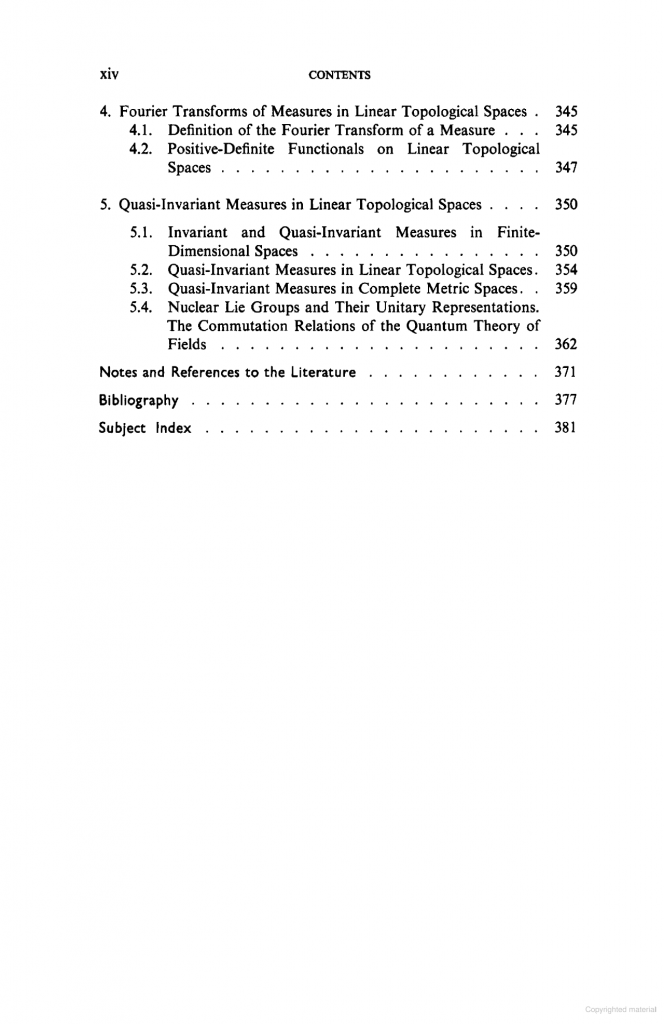
Lev Landau, Evgeny Lifshitz – Statistical Physics 1
Statistical physics holds an underappreciated keystone role in physics. At face value it has a lot to offer as an emergent description of systems with high degrees of freedom such as gases, quantities like heat, a description of phase changes, and complex but practical phenomena including nucleation during a phase change. Due to this, it comes off as esoteric in focus and in its mathematical structure, were it not that the continuum limit of discrete objects in statistical physics are precisely those in quantum field theory. As such, statistical physics occupies a fundamental role in the study of dynamics.
For a symplectic approach to statistical mechanics see Souriau’s book.
For lattice statistical models, Baxter on Exactly Solved Models in Statistical Mechanics.
For the rigorous analogy to quantum field theory, there is the area of statistical field theory. One good introduction by Itzykson and Drouffe is here. And volume 2. Here is an MIT OCW course on the subject with various references.
Statistical field theory (and stochastic quantization) originate with Giorgio Parisi as ideas, which later led to his work on dimensional reduction – turning a classical statistical field into a quantum field theory in two fewer dimensions
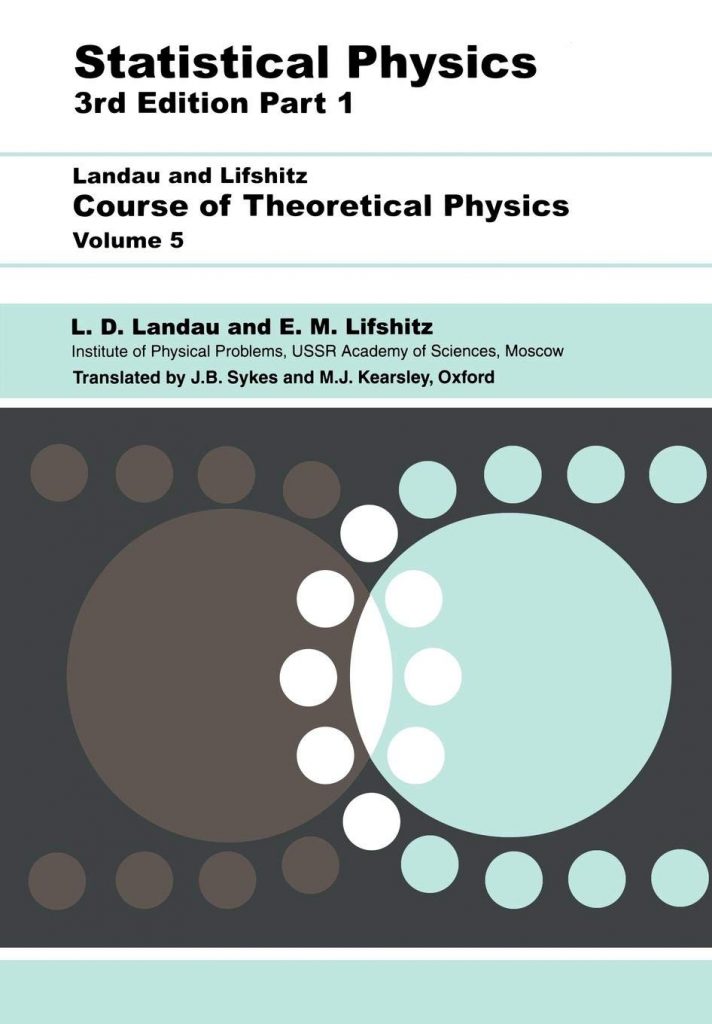
Table of Contents




Steven Weinberg – The Quantum Theory of Fields
Once again, there are three books, so we will summarize them generally and then per-volume below. Weinberg takes a middle road between directly showing how practical calculations are done and the geometric picture. The core of this compromise is to elevate the representation theoretic Wigner classification of particles in volume 1 to the beginning, and to make it as clear as possible what quantum field theory is about and how to make sense of it. Landau 4 on quantum electrodynamics thus makes a good companion, focusing on the special case of electrodynamics but being compatible with the formalism here. You will come out of volume 1 as an expert on the fundamentals of QFT, volume 2 bridges to the gauge geometry central to much of this list, and volume three, supersymmetry. See below for more:
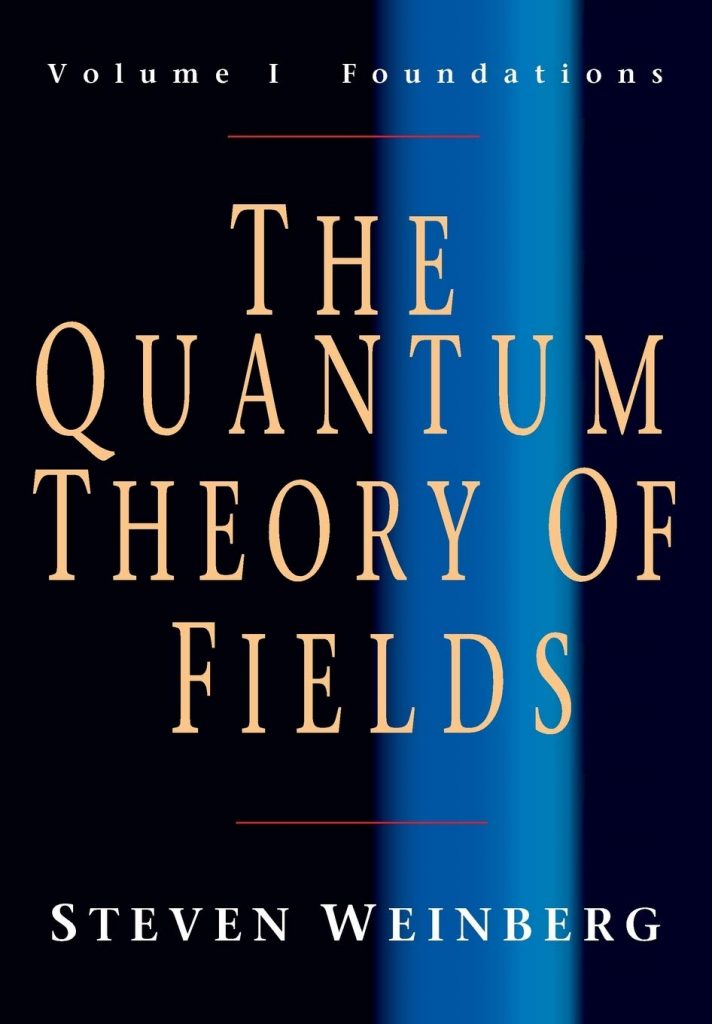
Table of Contents
Volume 1: Foundations
This volume contains the basic tools to do quantum field theory, coming from quantum mechanics, which we would like to expound upon in another blog post. These tools have produced the most accurate scientific predictions in history, due to the relative accessibility of scattering experiments and their direct connection to the theoretical formalism and relativistically invariant particle Hilbert spaces.











Volume 2: Modern Applications
Beginning in a coordinatized version of the gauge theory from Atiyah Yang-Mills, analogies between the change of gauge to coordinate changes in general relativity are noted and immediately the many techniques in approaching the quantization of these force fields are listed. A focus on the physical content of the mathematics follows, such as the important applications to Electroweak symmetry breaking and instantons.









Volume 3: Supersymmetry
Supersymmetry has garnered a peculiar reputation as “not being physics.” It is the point of view of the authors of the fast track, who fundamentally care about physical reality, that supersymmetry just has not been properly understood. However, once the reader understands the already important classification of particles, you see that with supersymmetry and supergroups, this is the general situation in which something like particle physics works out. Thus it is worthwhile at least as a way to motivate future study and insight into known phenomena.









Modern Geometry, Algebraic Topology, Mathematical Foundations of Theoretical Physics:
Serge Lang – Algebra
There are essentially three books here. Although there never seems to be a good time to start algebra, it quickly becomes needed either for simplification or explanation of naturally arising structures everywhere. When your need for algebra is strong, consider picking the appropriate and helpfully self-contained sections. The basic objects of algebra, algebraic equations, representation theory of finite groups and related linear algebra. Applications are numerous and deserve a separate blog post.
This is a relatively long text, so it’s not strictly necessary to read it cover-to-cover (but you certainly could). It will serve as a preparatory springboard for later texts, though, so keep it around and read parts that are relevant to whatever else you’re studying. Vastly more lucid than Dummit & Foote.
For more homological algebra and modern topics such as derived and triangulated categories, D-modules and the Riemann-Hilbert Correspondence, refer to Algebra V by Gel’fand and Manin. There is another slightly different version of the book by the same authors, however this one has a gentler introduction going through some standard complexes to get a better flavor of the evolution into modern homological language. It equally serves to introduce ideas which will persist in algebraic topology and algebraic geometry.
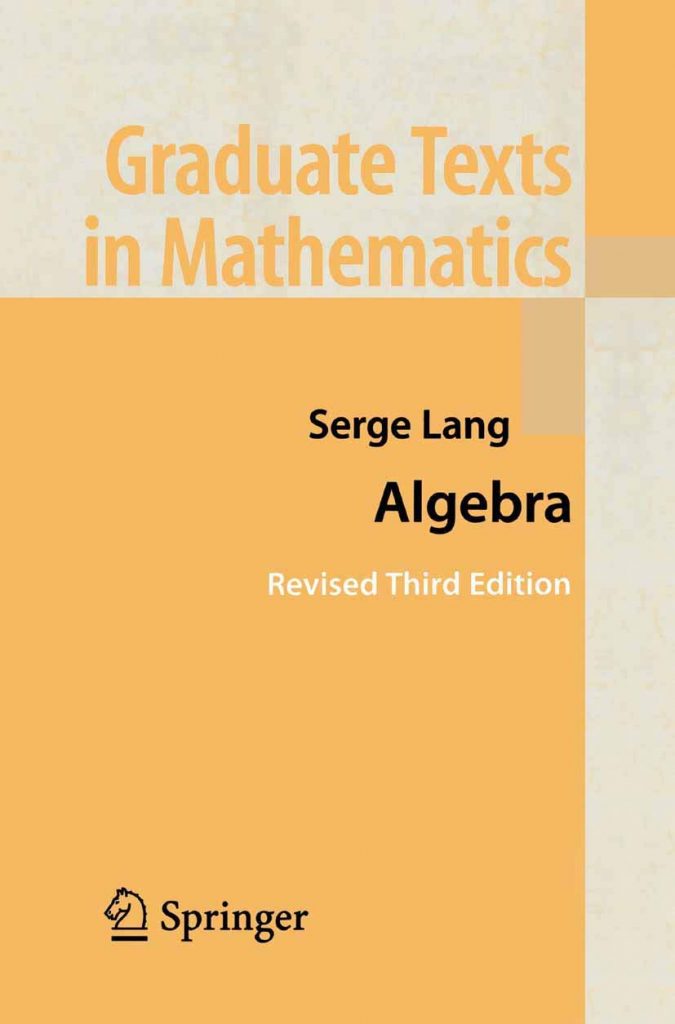
Table of Contents





John Milnor – Morse Theory
Morse theory, much like how differential forms and De Rham cohomology come from electromagnetism, arises as mathematical formalization of the principle of least action via critical points; Shown in volume one of Landau and in Sternberg’s variational calculus chapter of differential geometry. It is a reoccurring pattern that physical ideas help to give us mathematics in a particularly useful form, and here, it is the notion of energy and action that persists in geometry.
Applications are presented in the end, where the meanings of the important objects of the applications are explored in other texts as follows:
Symmetric spaces are a simple class of manifolds constructed by being symmetric under some lie group, spheres and hyperbolic spaces are included in this class. Explored in Kobayashi-Nomizu and Besse (related notion of homogenous spaces)
Bott periodicity exhibits a hidden 8-fold repeating pattern in the rotation groups, having instantiations in clifford algebras (Lawson-Michelsohn Spin Geometry) and homotopy groups of the orthogonal group and K theory (Atiyah and May).
Beyond this text, Morse Theory becomes a key aspect of the geometrical formulation of physics, and an analytical tool for Cobordism Theory. Schwarz, Morse Homology, constructs ordinary Homology analytically with Morse functions. Topological Field theory, based on Cobordisms, makes frequent use of Morse theory such as in this review by Freed. The infinite-dimensional case of Morse theory, Floer Homology, is generally studied in gauge theory contexts such as in Donaldson’s book. And of course, Milnor’s further writing on Cobordism and the h-Cobordism theorem.
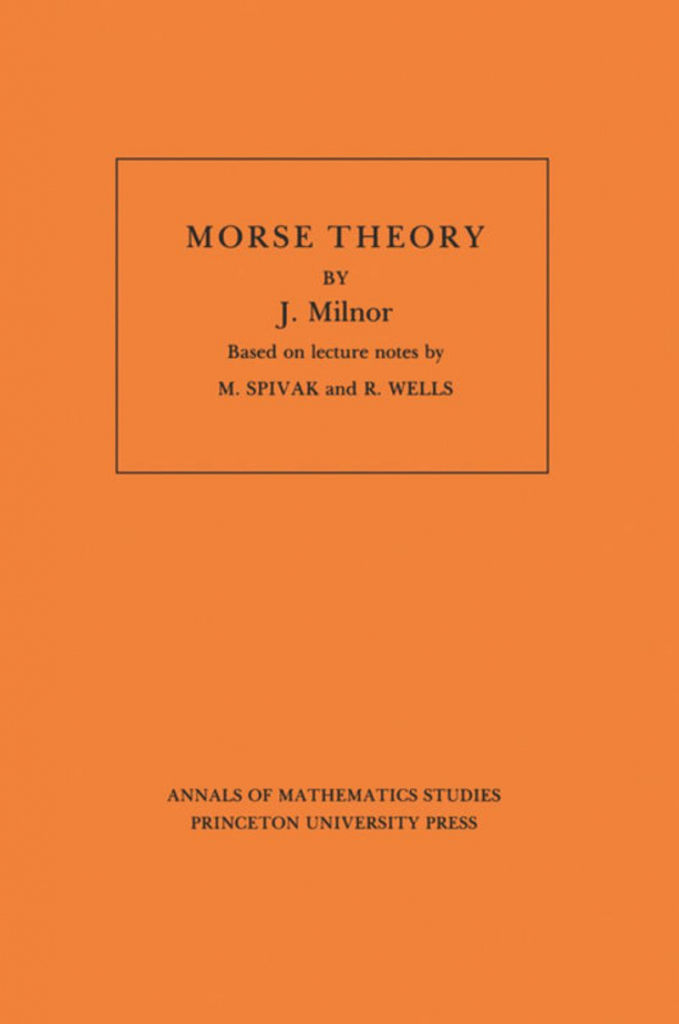
Table of Contents

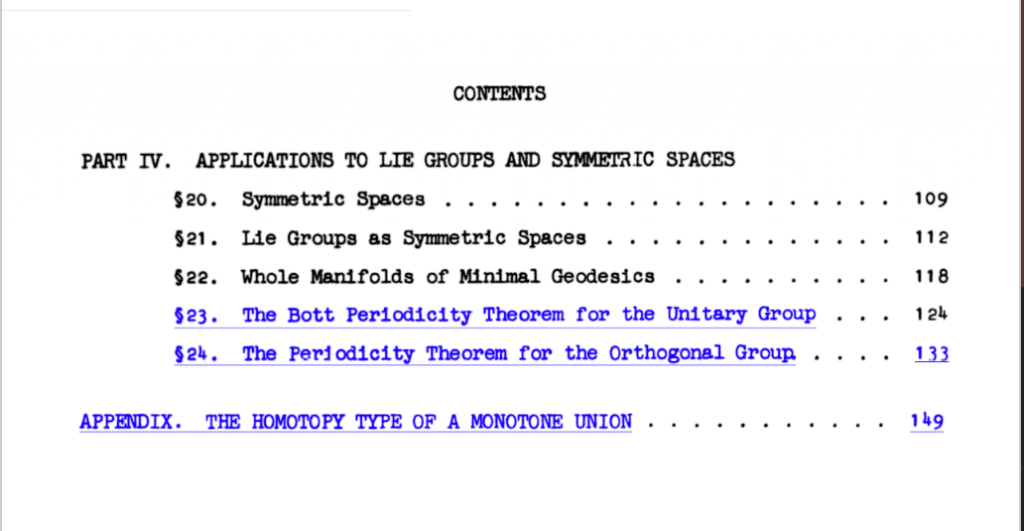
John Milnor, James Stasheff – Characteristic Classes
Hopefully the reader has encountered the geometric and algebraic background to be comfortable with hot-swapping different kinds of structures imposed on manifolds (and their convenient neighbor, CW complexes). The core idea of characteristic classes is group homomorphisms. Groups are used to directly characterize geometric structures on spaces, like the orthogonal group in the case of a metric and the special orthogonal for an orientation. Homomorphisms from these structure groups to simpler ones help to describe the choice of geometric structure, or in some cases, pose obstructions to the existence of one. Later, characteristic classes lead to what are called “topological quantum numbers” by the physicists.
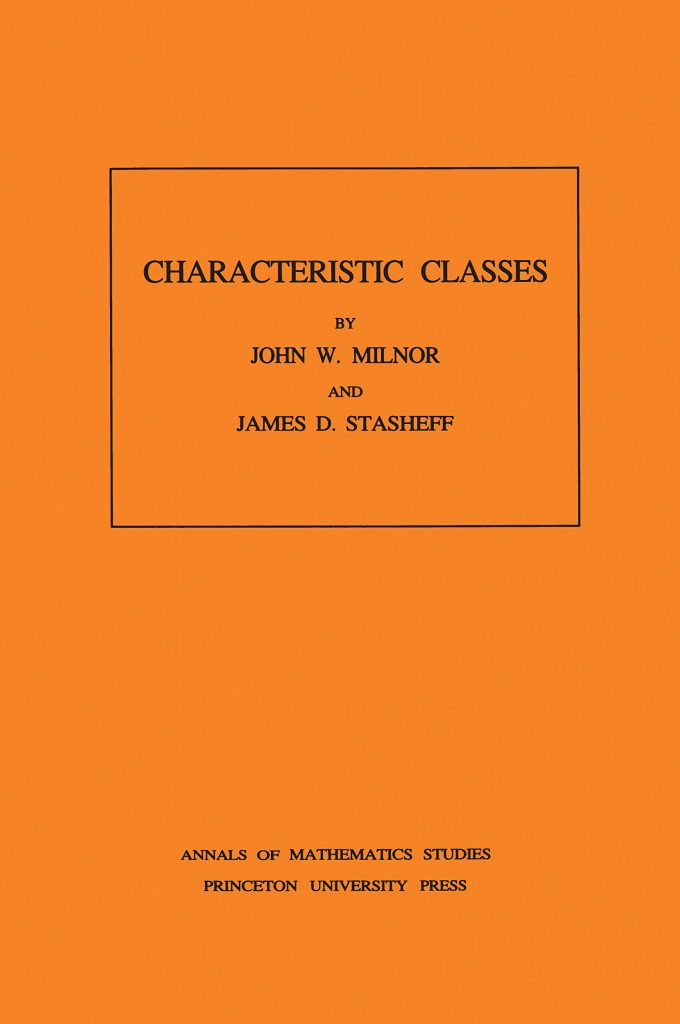
Table of Contents

N. M. J. Woodhouse – Geometric Quantization
This book is a culmination of the Hamiltonian mechanics in Landau 1, quantum mechanics, and the hints towards quantization given by Woit’s book. Symplectic manifolds are the object of study, the most general geometric situation in which a division of the coordinates into position-like and momentum-like is possible. The Hamilton-Jacobi equation introduced in Landau 1 in the same mechanical context is used as a precursor to the quantum Schrodinger equation, and the mathematical choices that must be made to recover quantum mechanics from the classical situation are laid out. While quantum mechanics seems to combine position and momentum as alternative choices of basis of a Hilbert space, symplectic mechanics keeps them separate as independent coordinates of phase space. The key structure from which position and momentum are merged to get a Hilbert space from symplectic geometry is a polarization. Further, symmetries on the symplectic manifold lead directly to quantum mechanical operators.
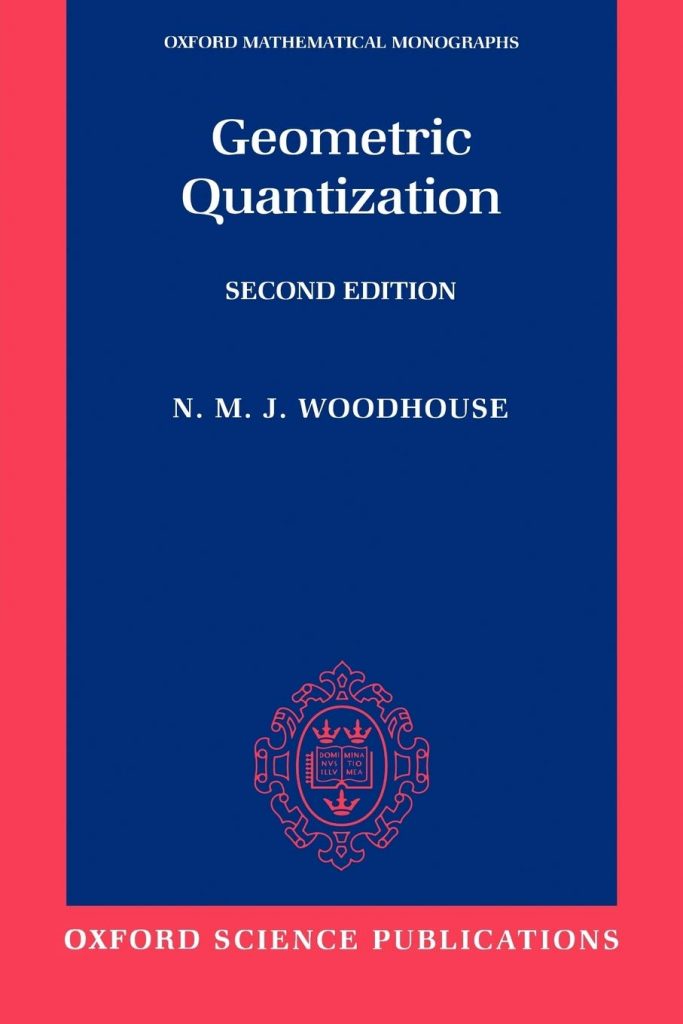
Table of Contents



Michael Atiyah – K Theory
K theory is a combination of topological spaces and linear algebra, where one considers a family of vector spaces, usually complex, parametrized by the points of a topological space. Operations with these families also known as vector bundles produce simple algebraic relations that both characterize the topological space and allow one to understand how to build complicated bundles from simple ones. In particular, a submanifold’s tangent bundle splits the tangent bundle of the total space into a pointwise sum – this machinery helps to identify the nature of maps between manifolds. As is typical in algebraic topology, K theory turns interesting but seemingly impossible to answer questions about geometry, the homotopy groups of rotation groups, elliptic differential equations, and the topology of spheres, into elementary polynomial algebra.
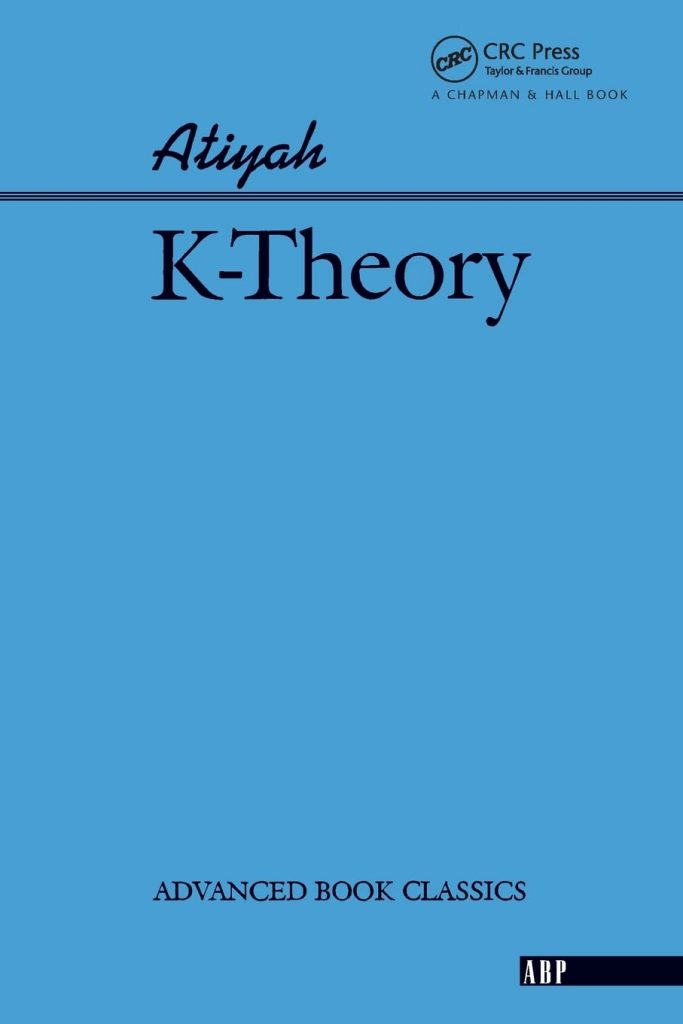
Table of Contents

Joe Harris, William Fulton – Representation Theory: A First Course
Per the summary of Serre’s text, understanding the structures of symmetry groups by means of linear algebra is one of the most powerful computational and qualitative tools in mathematics. This book focuses on the cases of finite groups, real and complex lie groups which the reader has seen in Landau QM to describe the symmetries of molecules and implicitly everywhere else (or in Olver) for the latter. The actual classification takes place for complex semisimple Lie algebras with Dynkin diagrams, while the real case still passes into it as is typical in algebra. The refinement using real forms is explained in Helgason’s book and leads to the theory of symmetric spaces, which continues in the books by Kobayashi and Nomizu. While Olver focuses on the local structure of lie groups to determine differential equations, the global shape is considered here through linear representations as is typical in treatments of Lie theory.
A ludicrously brief book on Complex Semisimple Lie Algebras by Serre.
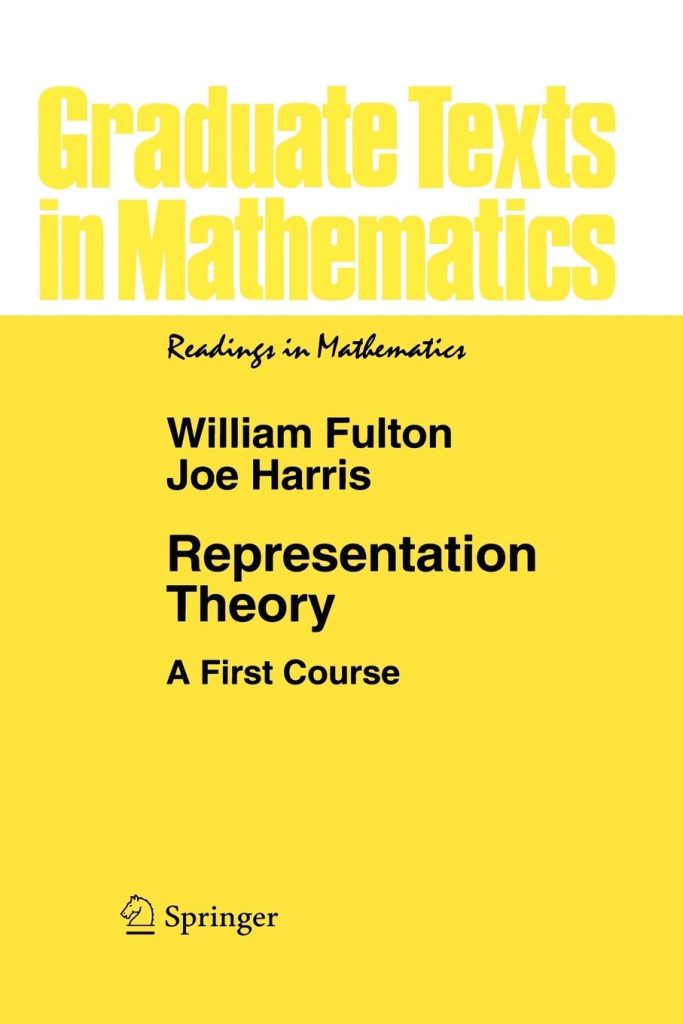
Table of Contents





Jean-Pierre Serre – Lie Algebras and Lie Groups
The structure of Lie Algebras and Lie Groups is a central result in mathematics and physics we often grab when setting up all kinds of geometric scenarios, while this text doesn’t have the comprehensive focus on the usual real case (compare to Fulton-Harris which does the classification in the complex case), it presents the theory in a brief algebraic manner which is also applicable to questions of pure algebra and p-adic analysis that are typically excluded from other treatments. This material is especially important in homological considerations.
To understand the naturality of considering the p-adics, the reader might wish to consult Serre’s A Course in Arithmetic and specifically Ostrowski’s Theorem.
This collection of notes by Diaconis on Probability and Representation Theory is designed to follow this book of Serre’s. Another text by Serre one might wish to consult is his Linear Representations of Finite Groups.
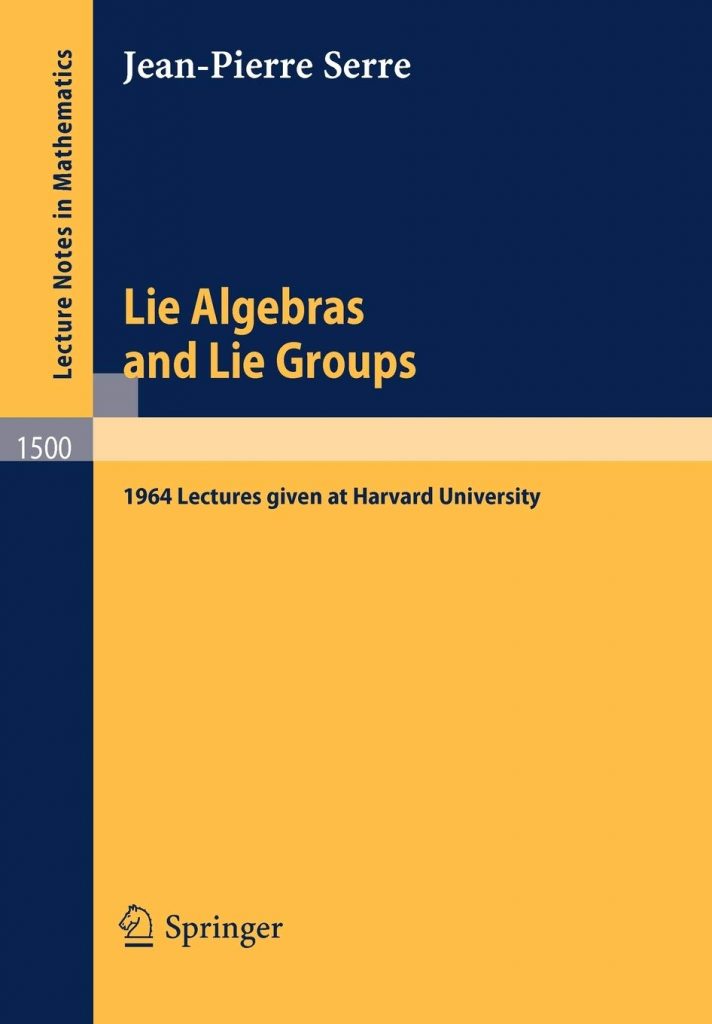
Table of Contents



Katsumi Nomizu, Shoshichi Kobayashi – Foundations of Differential Geometry
This would be a difficult first read on differential geometry, and it was hard for the authors of this list to fit it in earlier. It does however give a comprehensive treatment to any overlooked topics in Sternberg’s text, and gives a wide enough base to ease into further differential geometry study.
In particular, volume 1 starts immediately with the theory of connections and curvature, featured late in Sternberg.
Volume 2 contains the basic theory of complex manifolds and defines the Chern-Weil homomorphism (mentioned briefly at the end of Characteristic Classes by Milnor) which determines the relationship between curvature forms and the topology of vector bundles.
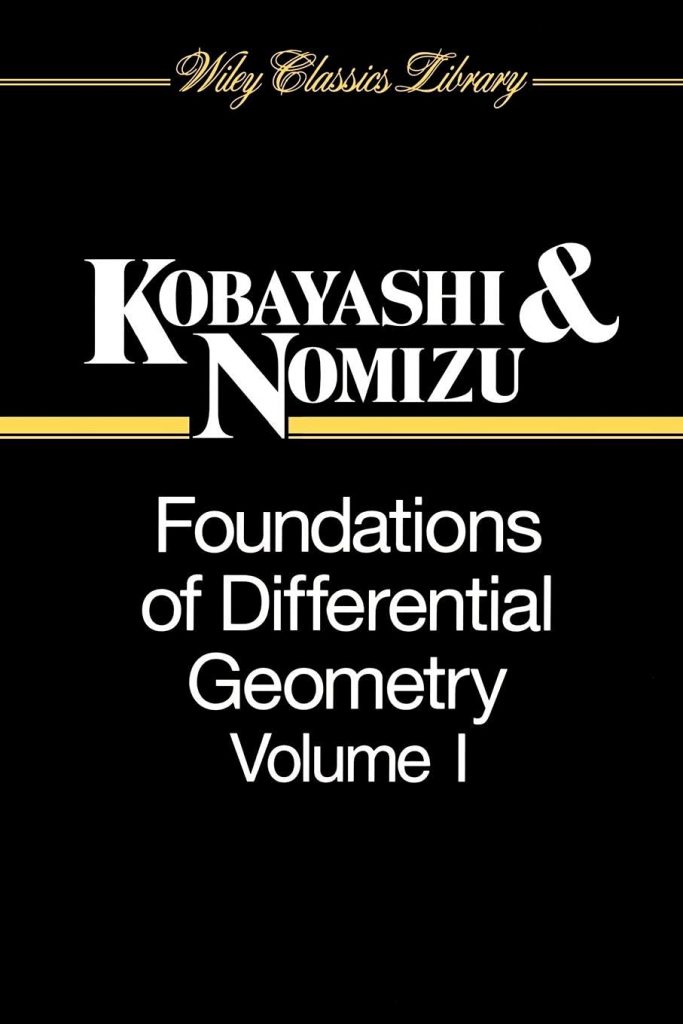
Table of Contents
Volume 1



Volume 2



Michael Atiyah – Geometry of Yang-Mills Fields
Yang-Mills theory studies dynamics guided by another sort of curvature which does not come from a more fundamental or intrinsic metric field in the case of Riemannian and Pseudoriemannian geometry. This curvature does, however, come with a freedom to choose a “gauge group” which takes an analogous role to the tangent bundle coordinate transformations in the previous case. Like Riemannian curvature, it is framed in terms of vector bundles over the space in question and transformation laws of the local field expressions. The choice of gauge group G produces different kinds of charges, some of which we see in nature, but also a new homotopy-invariant phenomenon called instantons. Interpreting these instanton solutions to the field equations of motion tells us that these instanton solutions exist not as underlying curvature fields on space, but each homotopy class coming as fields on different twisted G-principal-bundles over space. Each individual instanton should be thought of as containing a deformation class of curvatures as in the case of Einstein structures studied in Besse’s text.
This geometric point of view is elaborated on, unlike the analytical description in physics texts, and applications like the algebraic geometry conversion to twistor space are discussed. While these applications are why this book is favored in academic circles, the authors of the fast track believe there is hidden value in the simple and direct basics presented here too. This book also marks the entrance into the geometric flavor of analysis developed along the lines of Atiyah and Bott’s paper on Yang-Mills over Riemann Surfaces, Topological Quantum Field Theory (e.g. Witten), and Donaldson’s investigations into instanton moduli spaces.
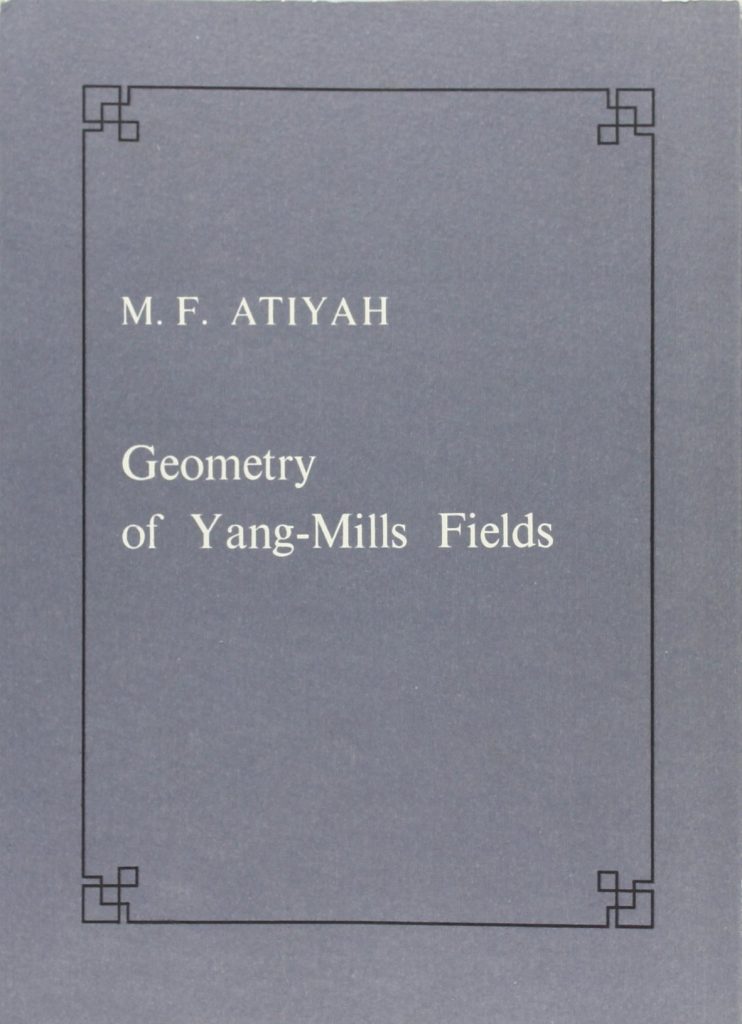
Table of Contents

Robin Hartshorne – Algebraic Geometry
Algebraic Geometry is foremost about the geometries of solutions to algebraic equations and other locally ringed topological spaces whose functions also behave like such solutions. The subject is most easily studied in analogy to differential geometry, and insights cross feed since both kinds of spaces (manifolds and schemes) can be constructed as dual to certain kinds of rings. Aspirationally, this means that we want to be able to describe geometry in terms of purely algebraic structures. One fundamental analogy worth noting is that both classes of geometries have a notion of fundamental groups and covering spaces, where in the algebraic case, fundamental groups are a general case of Galois groups in algebra. Additionally, complex algebraic geometry makes heavy use of differential form techniques and symplectic geometry.
At the center of the abstract geometric formalism are still concrete cases of solutions to equations over algebraically closed fields like the complex numbers in linear/affine or projective space called varieties. The later parts of the book concern themselves with historical problems on elementary and easy to see examples using the powerful sheaf and cohomology formalism built in the intermediate chapters. We have seen sheaves earlier in this list, however, as early as in Ahlfors’ and Bott & Tu’s books. It is also worth noting that algebraic and differential structures can and have been combined, and are a modern topic of study stemming from quintic threefolds such as Calabi-Yau.
The original source of the analogy to differential geometry is the wealth of results originally constructed in complex analysis and manifolds, which were later replicated purely algebraically. Listing these would be too long here, but some directions include:
– the basic theory of Riemann Surfaces (Ahlfors, Donaldson) and algebraic curves (Griffiths, Harris)
– multivariable complex analysis (Krantz, Gunning)
– Differential Geometric ideas (Hirzebruch, again with modular forms)
– Hodge theory (Kobayashi-Nomizu and Jost via Riemannian geometry, Voisin via complex geometry, and the differential geometric case leads to spin geometry and later index theorems: Heat Kernels and Dirac Operators by Getzler, Vergne, and Berline)
– Deformation, Moduli, and Geometric Invariant Theory (Harris, Mumford)
In the introduction to his book on Toric Varieties, Fulton suggests that working algebraic geometers rely on good sources of examples. Riemann surfaces in complex analysis, projective and affine curves, or even Grassmannians appearing in characteristic classes or soliton/KP hierarchy theory. Toric and tropical geometry are another such source. When specialized to projective spaces, the torus action corresponds to the momentum map (a.k.a. geometric invariant theory) of symplectic geometry and spaces of probability distributions. A more sophisticated application to string theory and collected references is in Gross’ book.
The formalism of algebraic geometry works equally well in number theoretic settings, and has been at the center of results such as the proof of the Weil conjectures and the Modularity theorem. For an overview of this direction: Introduction to Modern Number Theory, Manin. Our point of view is that these developments may play a role in our future understanding of computation and numerical differential equations, relating the discrete and continuous worlds.

Table of Contents



H. Blain Lawson, Marie-Louise Michelsohn – Spin Geometry
Spin geometry is presented here as a subfield of Riemannian geometry, where the core construction is the lifts of the special orthogonal groups of any signature to corresponding double covering spin groups. These spin groups are realized inside of the group of units of the Clifford algebra, which is constructed directly from the vector space the orthogonal structure is on. As over a manifold, the collection of tangent vector frames over a point gives a copy of the orthogonal group, “spinors” are the corresponding vector quantity whose frames are the spin groups, and a calculus for them is developed. Spinors appear semi-implicitly in Landau 3 to describe angular momentum, but they are as fundamental to geometry as a square root of geometry as complex numbers are to arithmetic. This appeared in Fulton-Harris and later in Fields and Strings as vector-valued quadratic forms on spinors. Our hope is that the reader appreciates the future potential of spinors and aids in their demystification.
The book focuses in three parts on the algebra of spin groups and Clifford algebras, the analysis of spinors on manifolds and the crowning achievement of the Atiyah-Singer Index Theorem, and finally geometric applications and relationships to curvature.
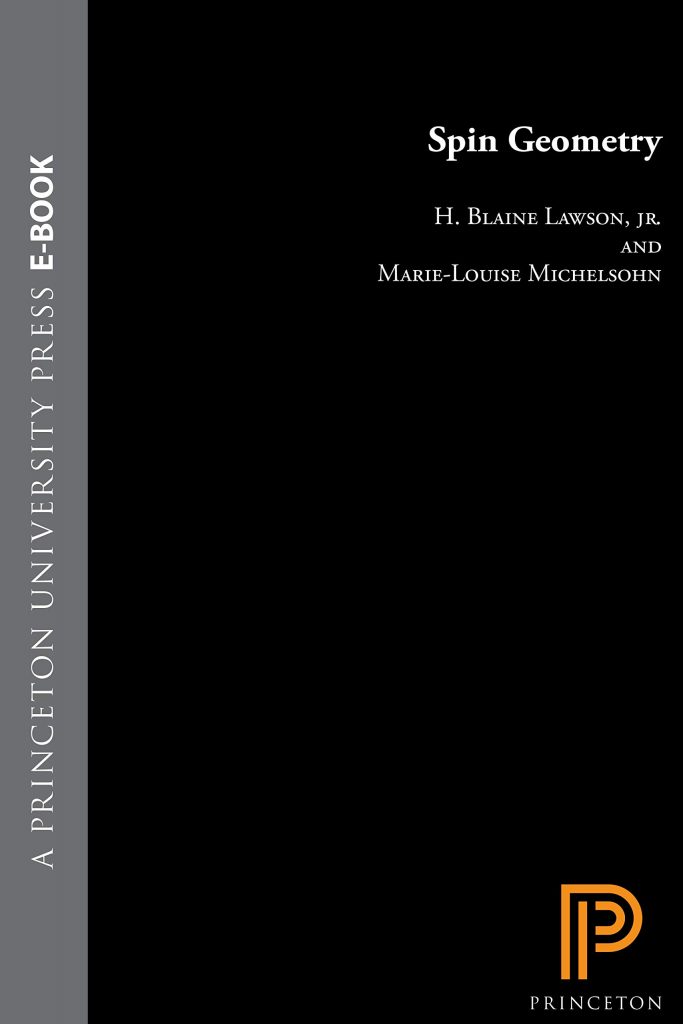
Table of Contents


Roger Penrose, Wolfgang Rindler – Spinors and Space-Time
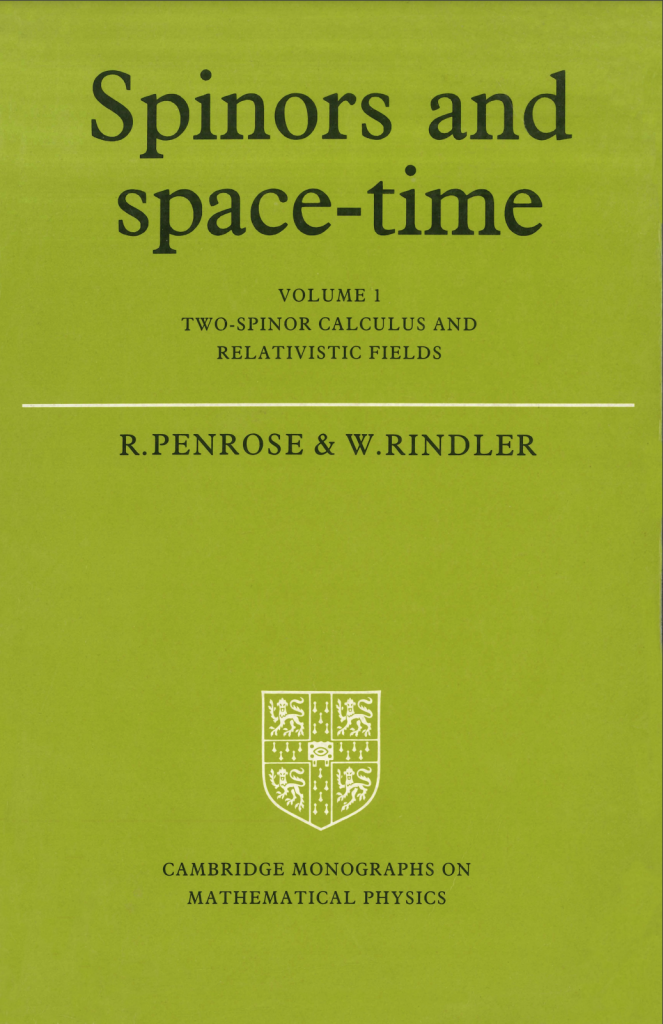

Table of Contents
General Relativity is founded on deriving dynamics from only a few geometric principles arising from the intrinsic structure of space-time, while many other useful theories of physics, other gauge theories, invoke extrinsic unexplained quantities to describe the properties of the forces and motion. While General Relativity uses tensors, which exist for general smooth manifolds, the spinor algebra supporting General Relativity is specific to our dimension. Spinors arose well after GR during the 20th century as another intrinsically definable vector quantity depending on the metric structure of space, first implicitly in Dirac’s work and formalized by Atiyah and others as detailed in the Spin Geometry text. These volumes by Penrose and Rindler concern the role of spinors in Lorentzian space-time. Volume one discusses how they fit into the existing framework of spacetime and electromagnetism, volume two towards an algebro-geometric generalization of space-time called twistor space produced by Penrose.
Volume 1
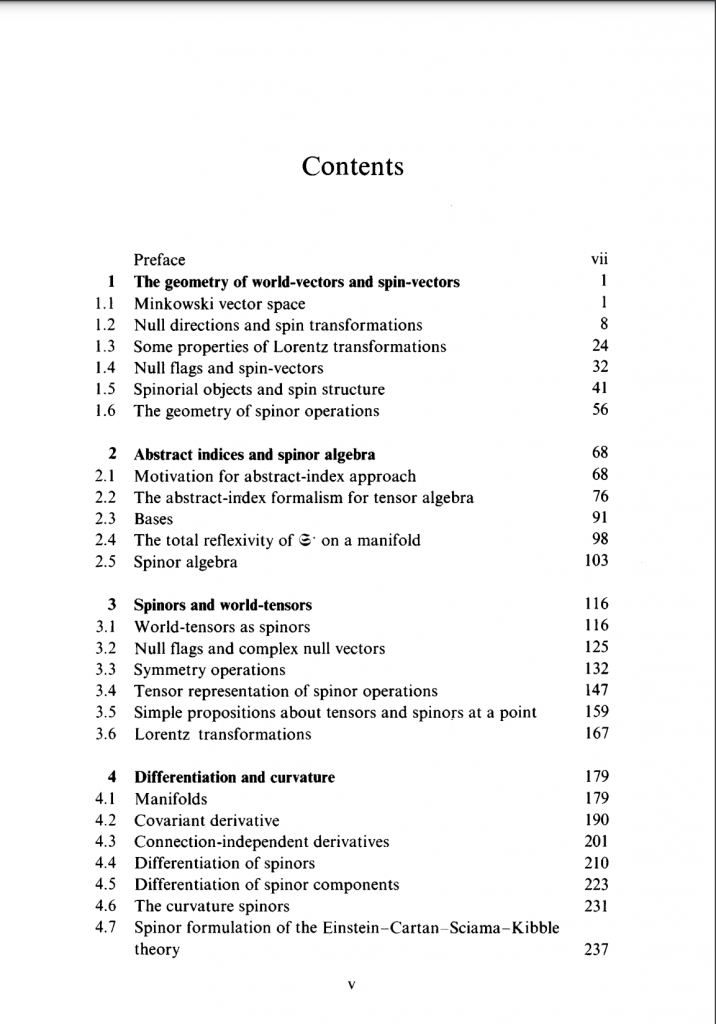
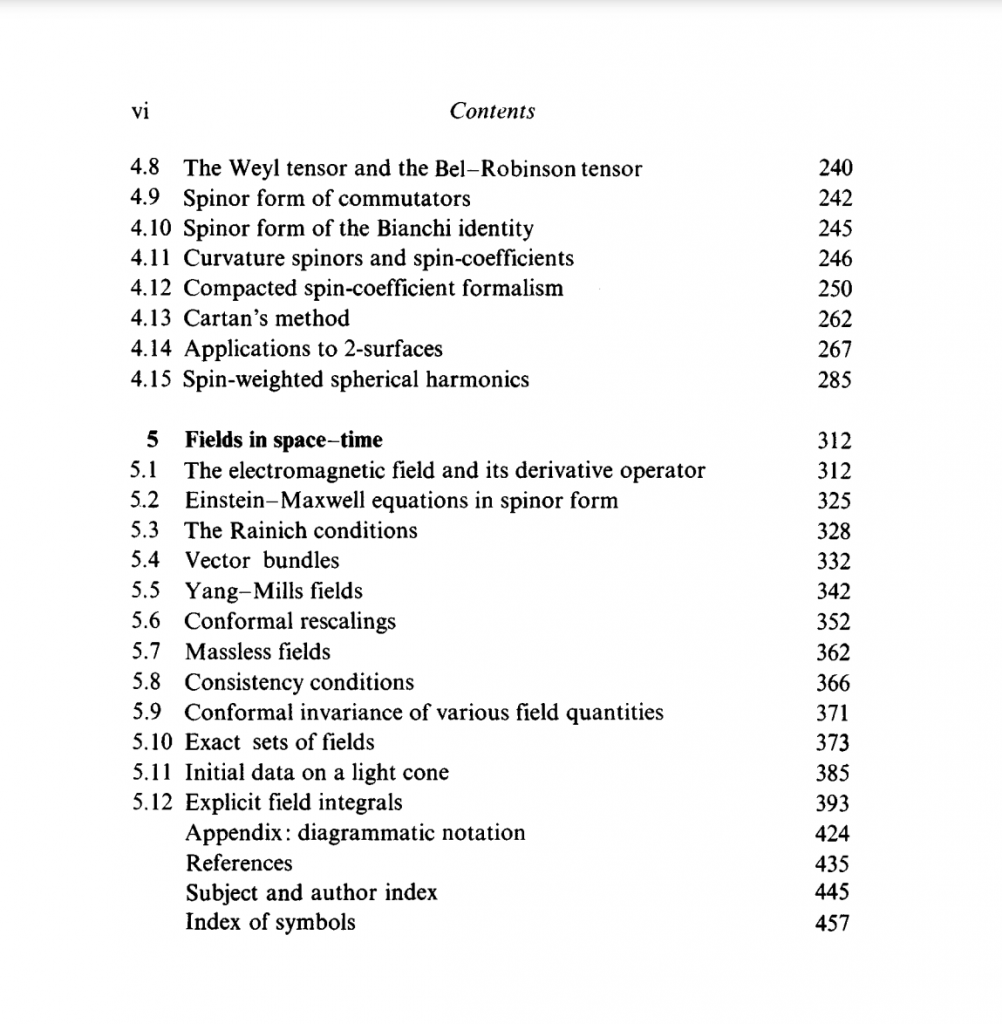
Volume 2
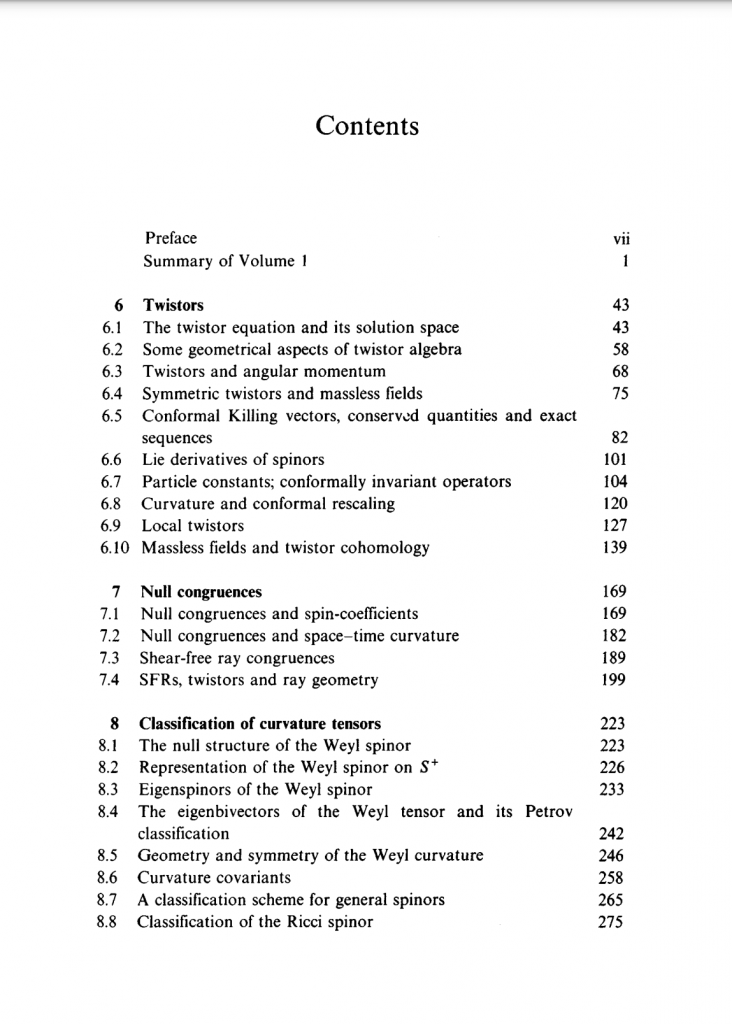

J. Peter May – A Concise Course in Algebraic Topology
This is the most expedient survey of algebraic topology available.
Algebraic topology is difficult to summarize, as you will see in the variety of chapter topics below. It has been adapted to many different flavors of mathematics and even physics and data analysis techniques (discrete exterior calculus, discrete Morse theory, persistent homology, and combinatorial algebraic topology). While it is our hope that readers get a sense of what fields of mathematics can accomplish, it is probably more effective to build up to Bott and Tu first as mentioned there. Additionally, algebraic topology interpretations of field theories in physics are an actively emerging subject, originating with the study of gauge theory and now topological quantum field theory.
Also serving as a nexus to many other topics, good books are given for further exploration of individual topics towards the end of May’s text, so we do not need to list many texts to take the subject further here. Still, we list a few by May and his collaborators:
– May, Ponto – More Concise Algebraic Topology: Localization, Completion, and Model Categories
– May – Simplicial Objects in Algebraic Topology
– Goerss, Jardine – Simplicial Homotopy Theory
– Freed – Lectures on Field Theory and Topology
– Ravenel – Complex Cobordism and Stable Homotopy Groups of Spheres
We have particular bias towards stable homotopy and cobordism due to the relationship of generalized cohomology theories and charges in field theories as outlined by Freed’s and Atiyah’s work.
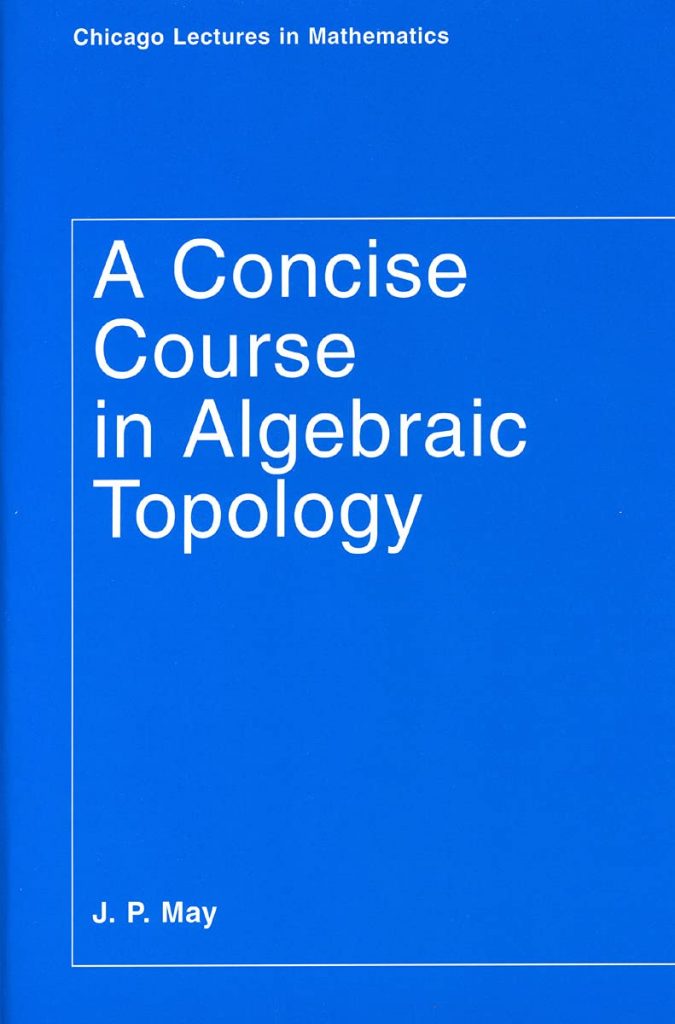
Table of Contents





Pierre Deligne, David Kazhdan, Pavel Etingof, John Morgan, Daniel Freed, David Morrison, Lisa Jeffrey, Edward Witten – Quantum Fields and Strings: A Course for Mathematicians
While the texts by Weinberg and DeWitt explore many physical consequences of quantum field theory with reasonable rigor, a host of areas of mathematics were created from the subject. This two-volume series covers a wide range of the theory from the point of view of mathematics, identifying structures and their interplay not present in the previous texts. Topics include supermanifolds, classical fields, gauge theory, functional integrals, conformal field theory, and strings.
Particularly important mathematical developments are the chapters on the Wightman axiomatization of quantum field theory, scattering and perturbation theory, and Witten’s chapter on the dynamics of (interacting) quantum field theory. Compared to the other two axiomatizations of quantum field theory (C* algebras/Haag-Kastler and topological quantum field theory), the Wightman formalism is the closest to how quantum field theory actually works in physics, though there are advantages to the others.
Given that an extensive portion of the book is classical field theory and ordinary quantum field theory, it is still invaluable for a learner not interested in string theory. It is also our belief that some useful mathematics lurks in the subject, so you can pick up the general basics without excessive investment away from physics.
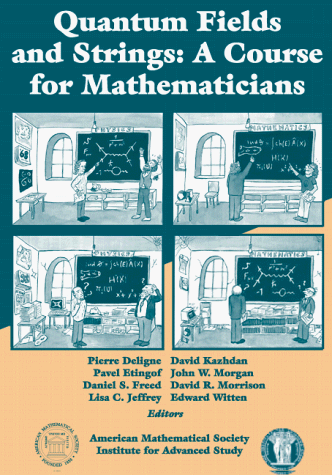
Table of Contents
Volume 1
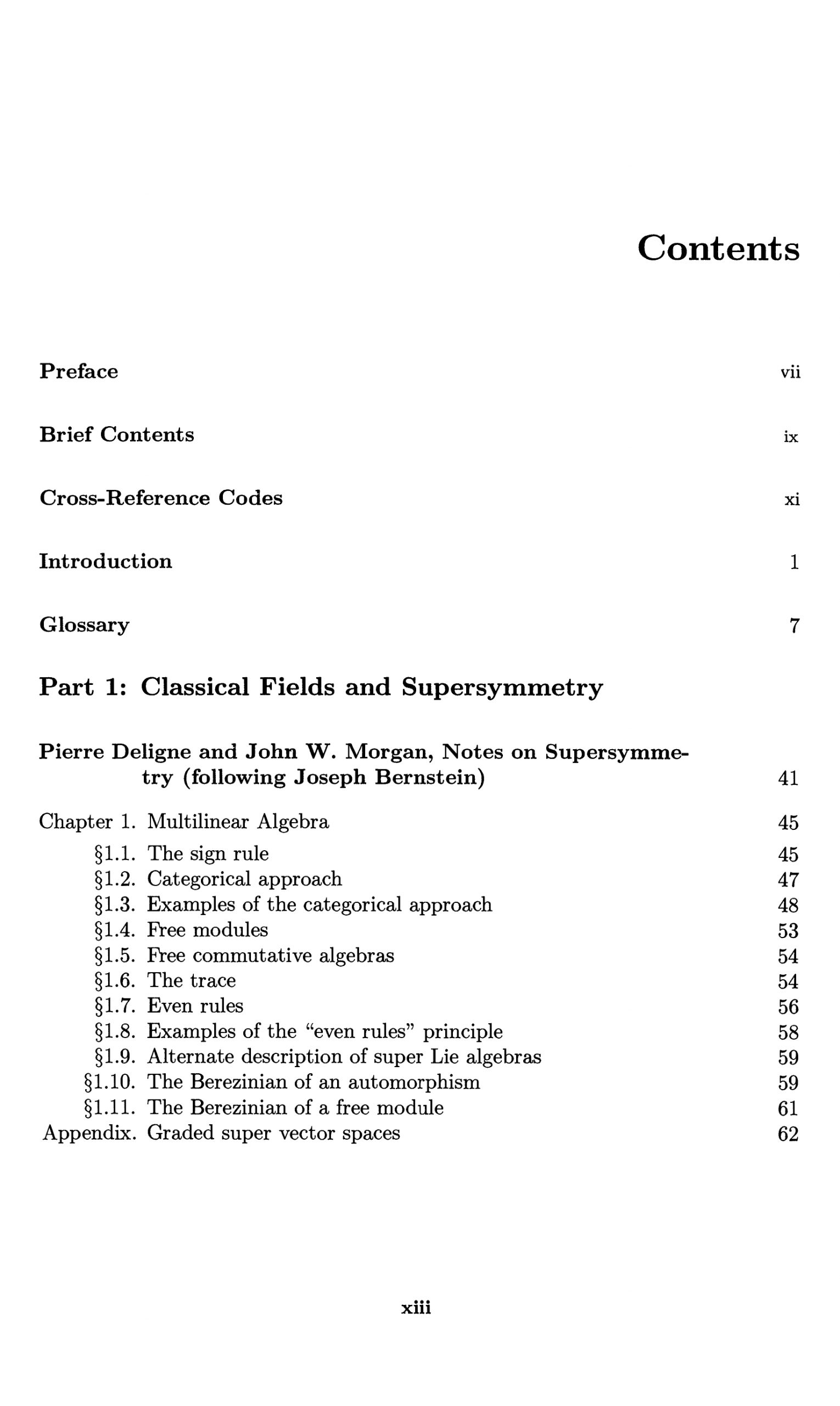

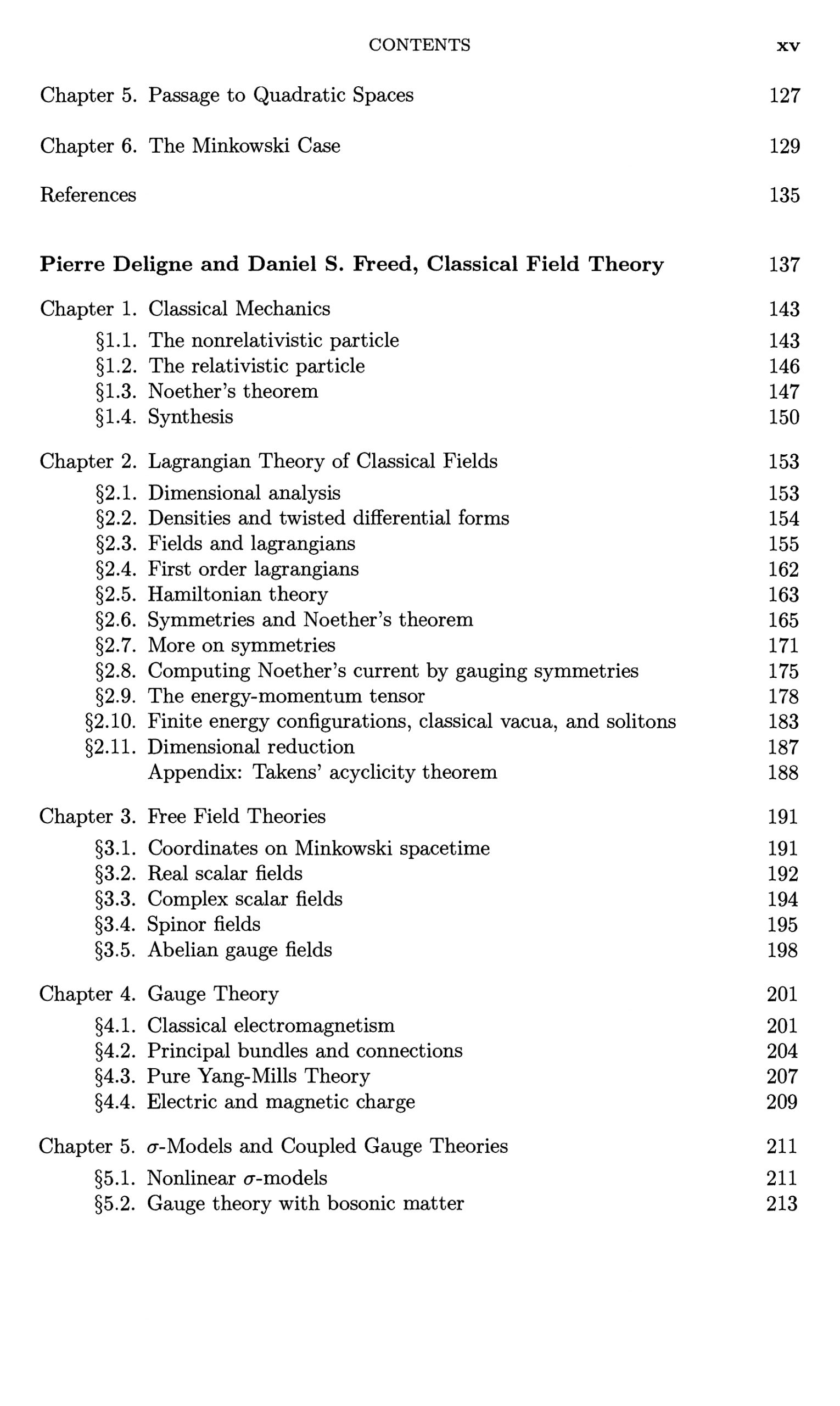
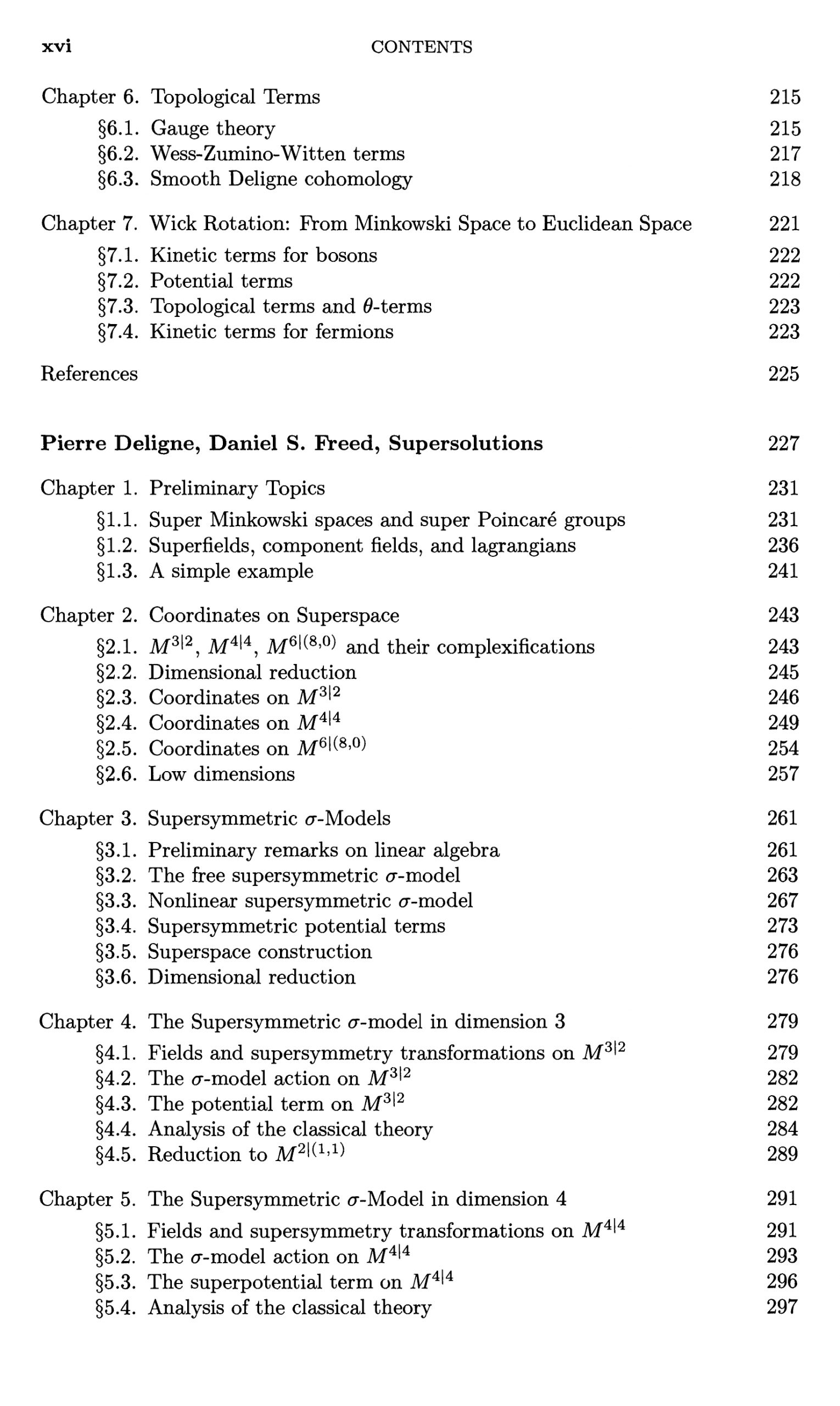
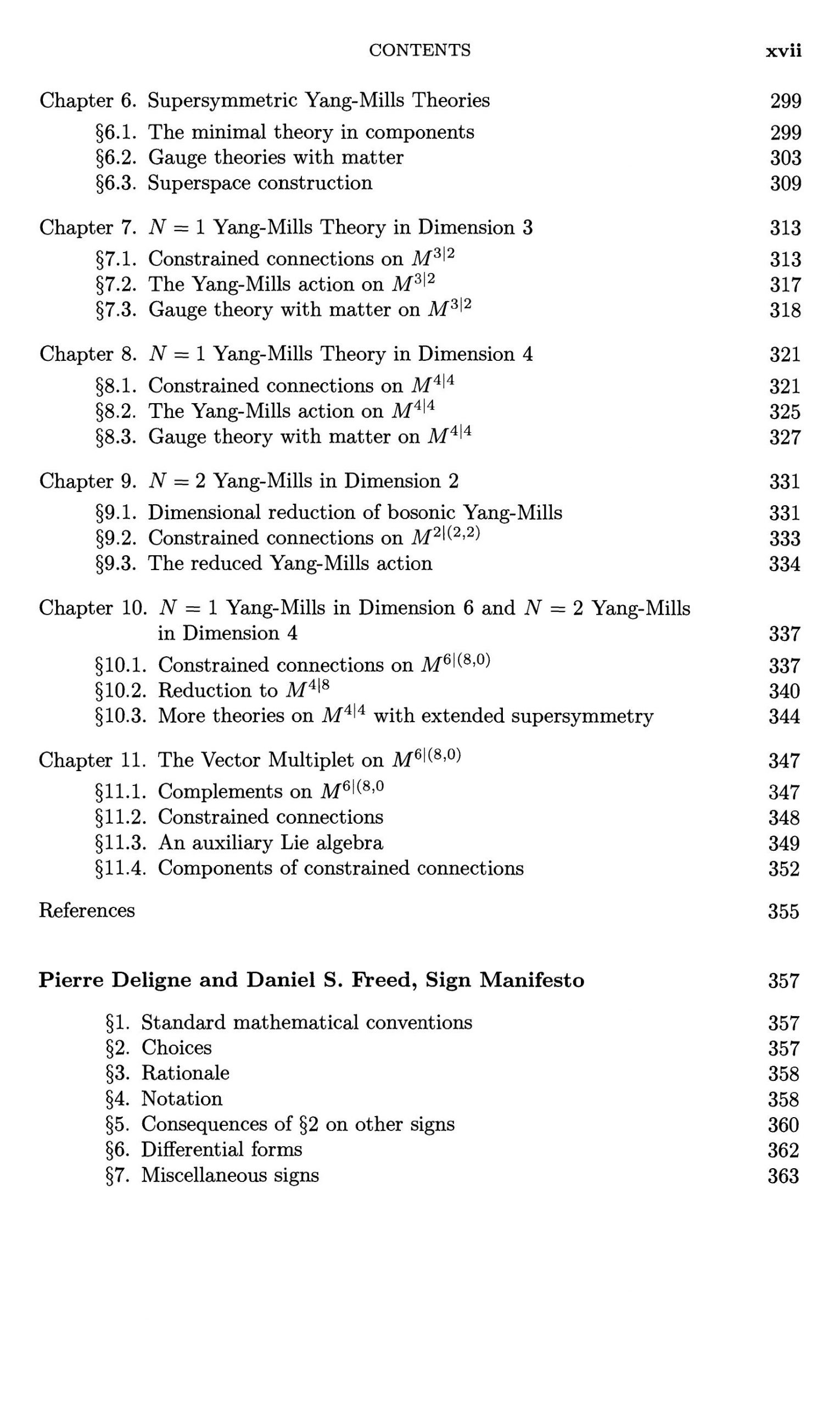
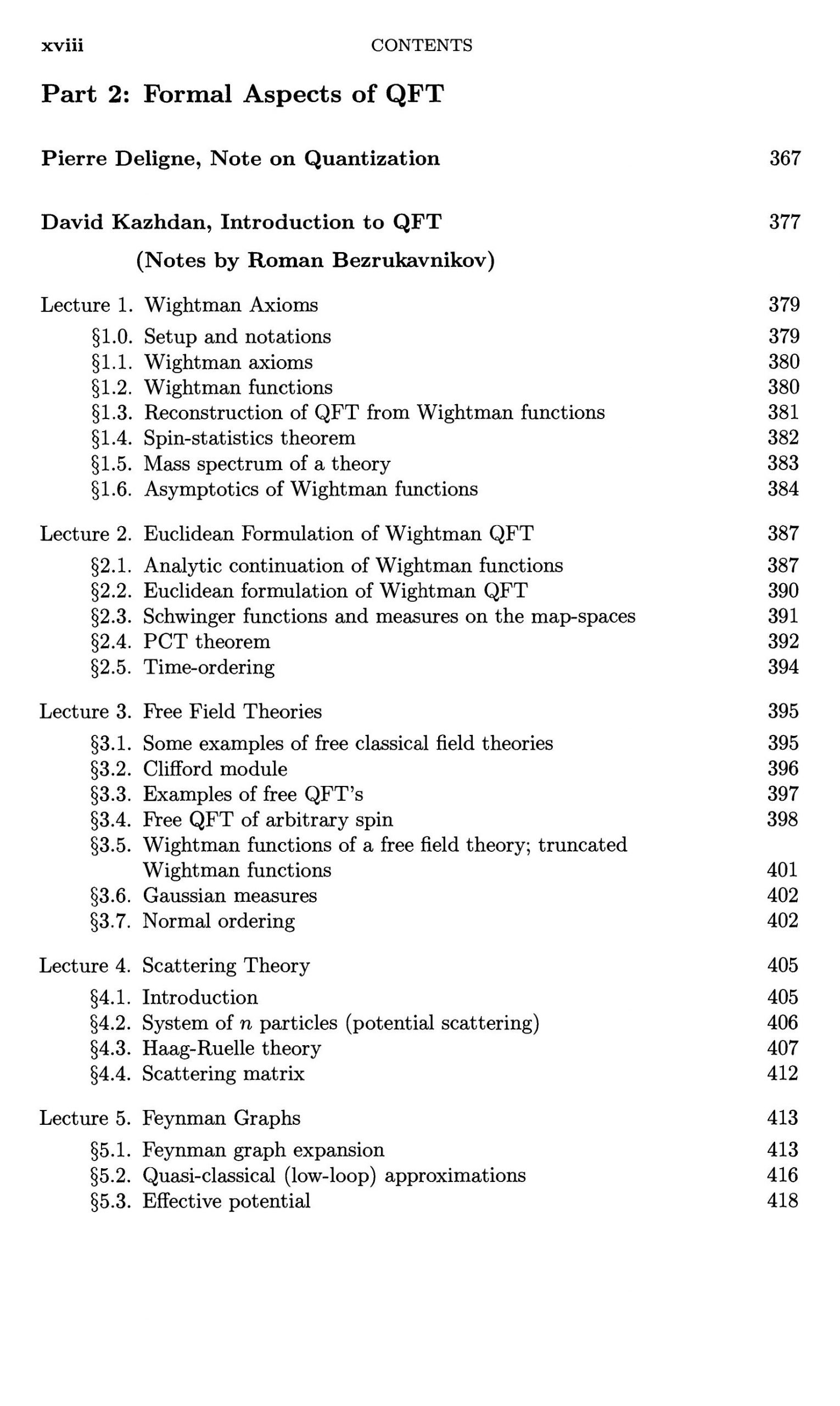
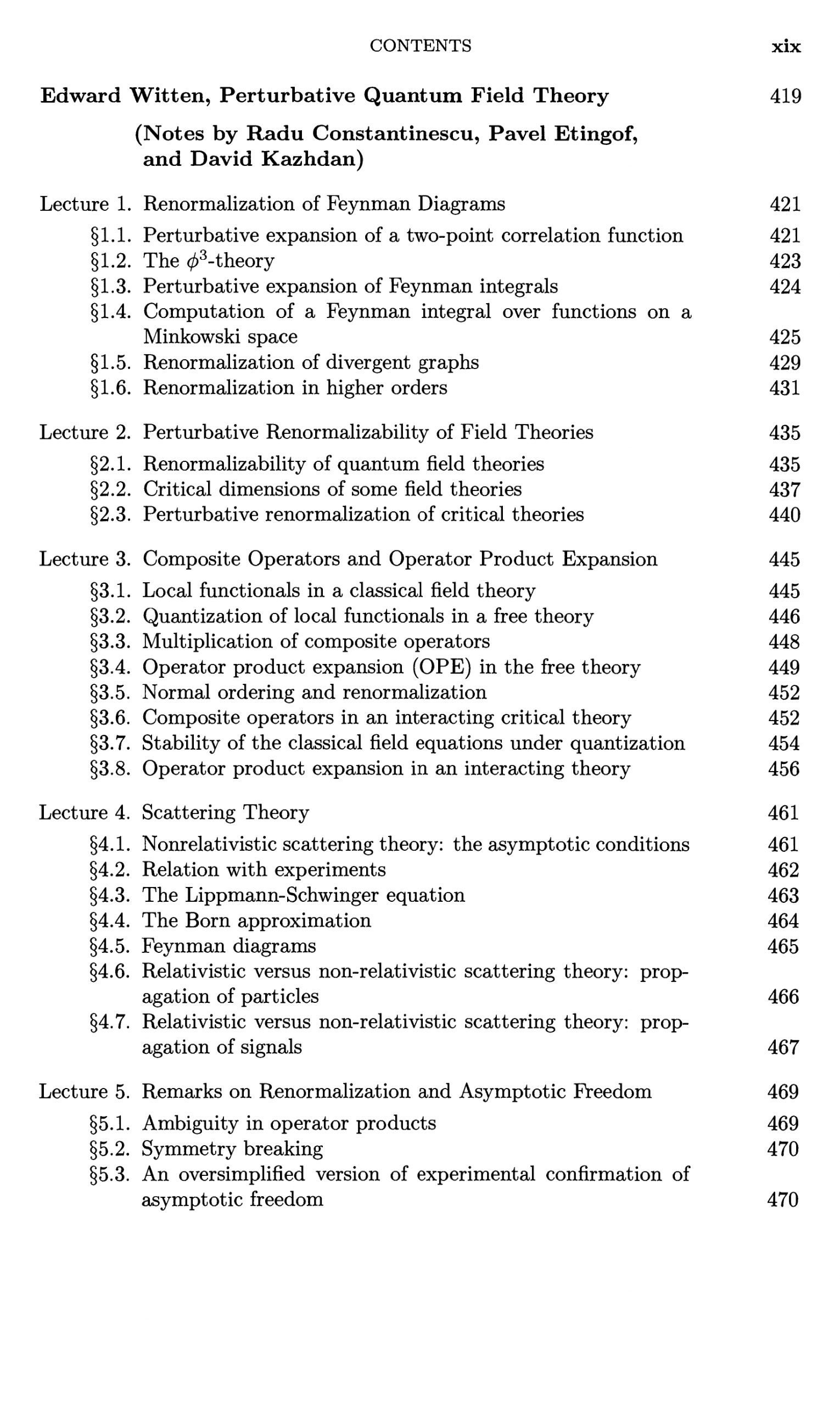
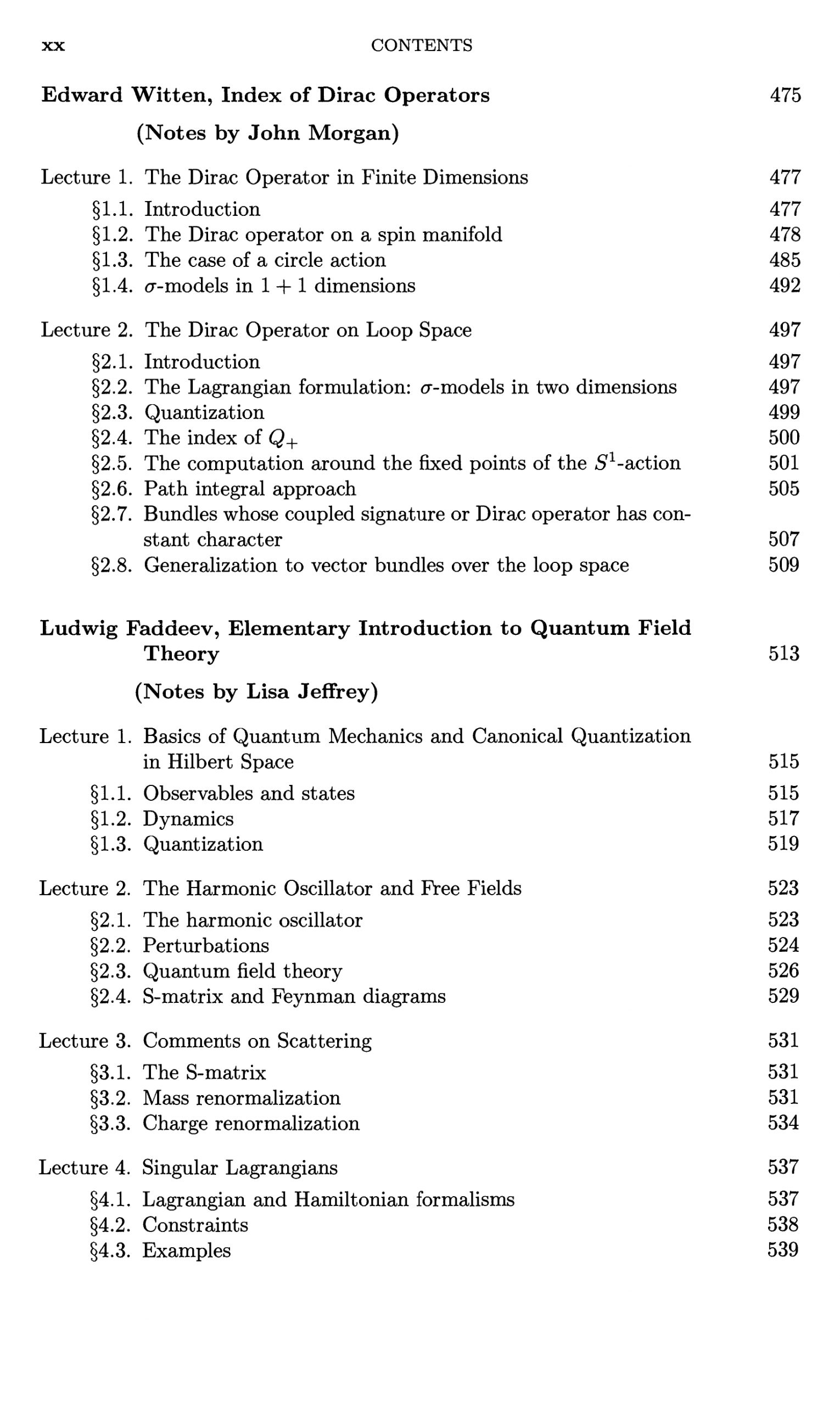
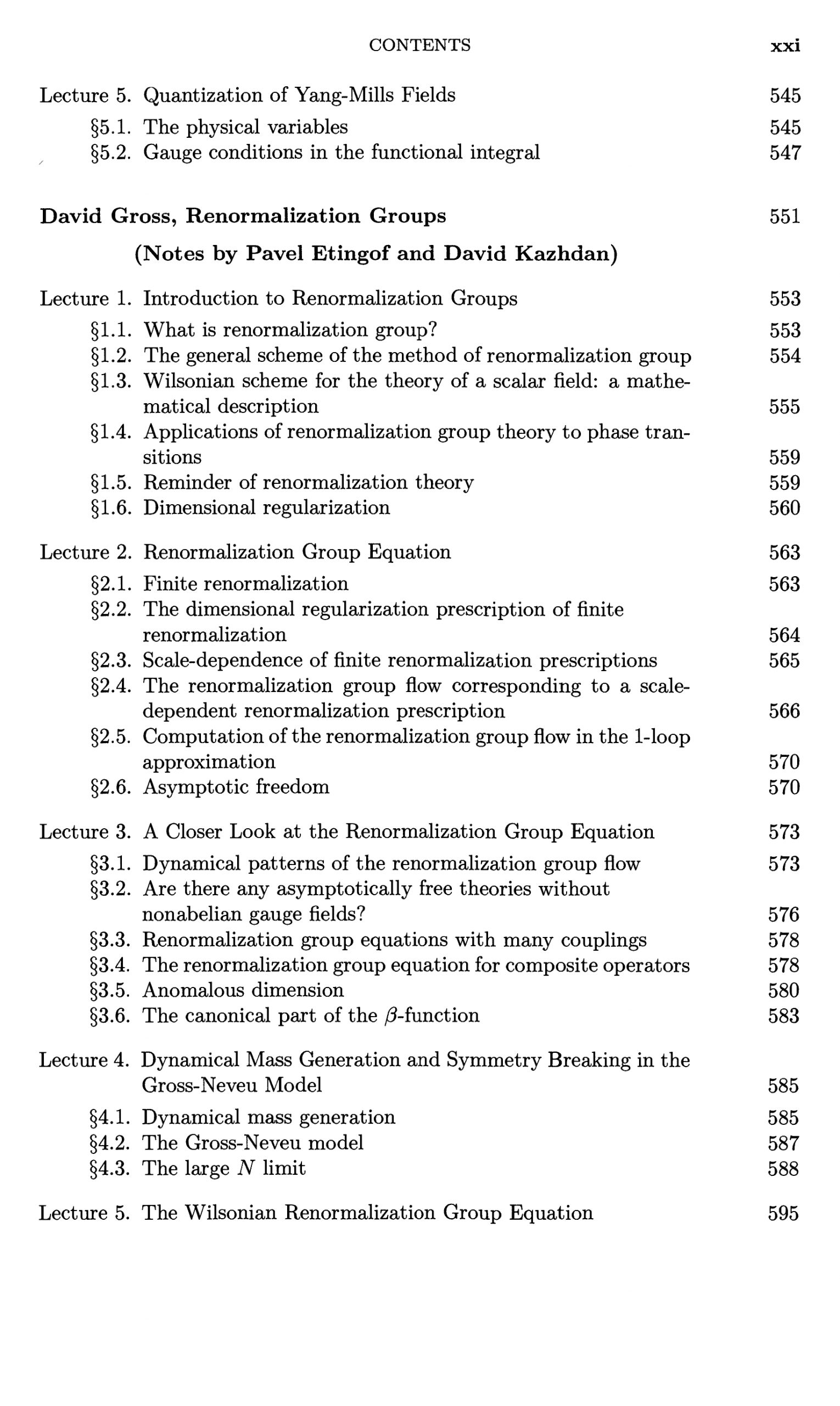
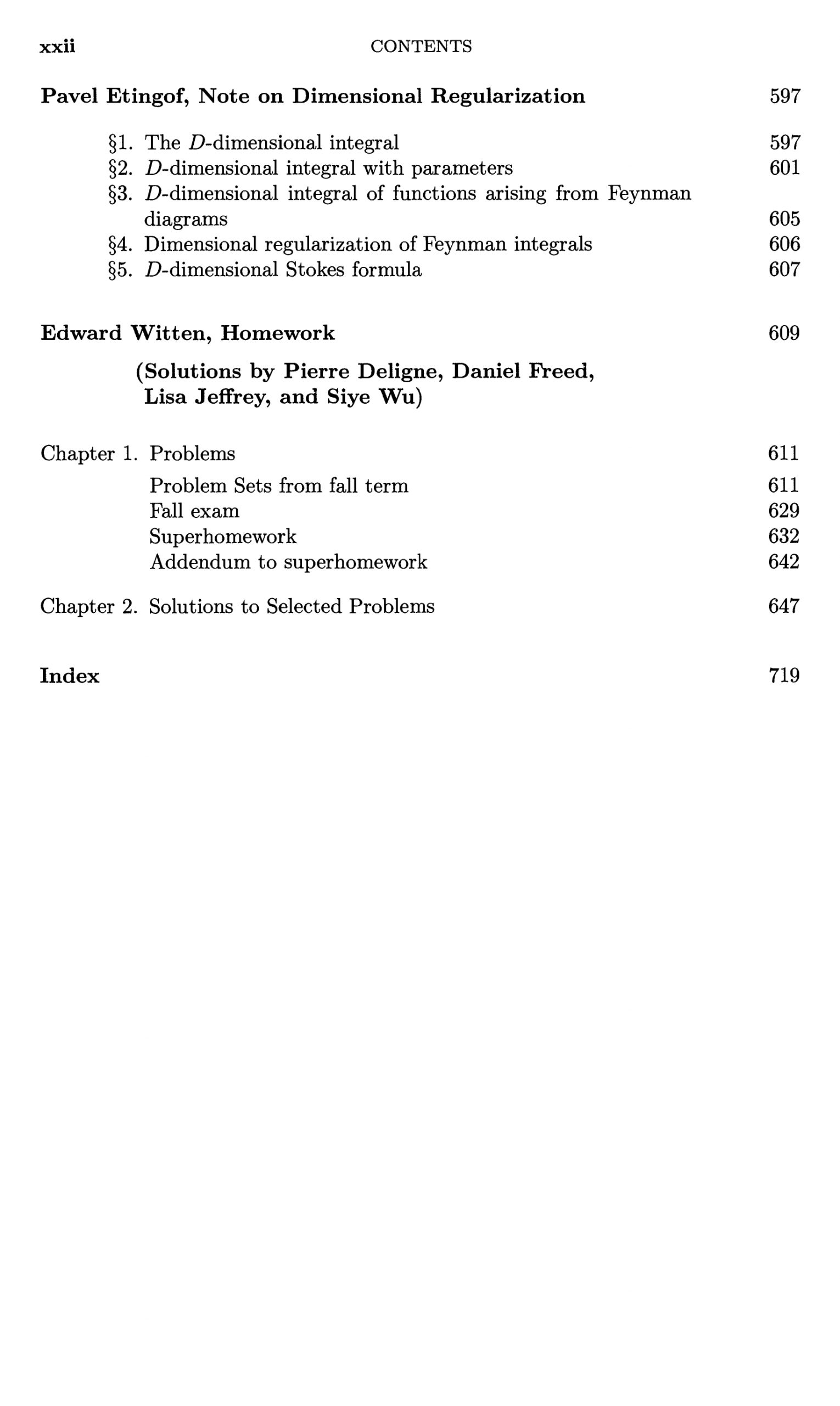
Volume 2
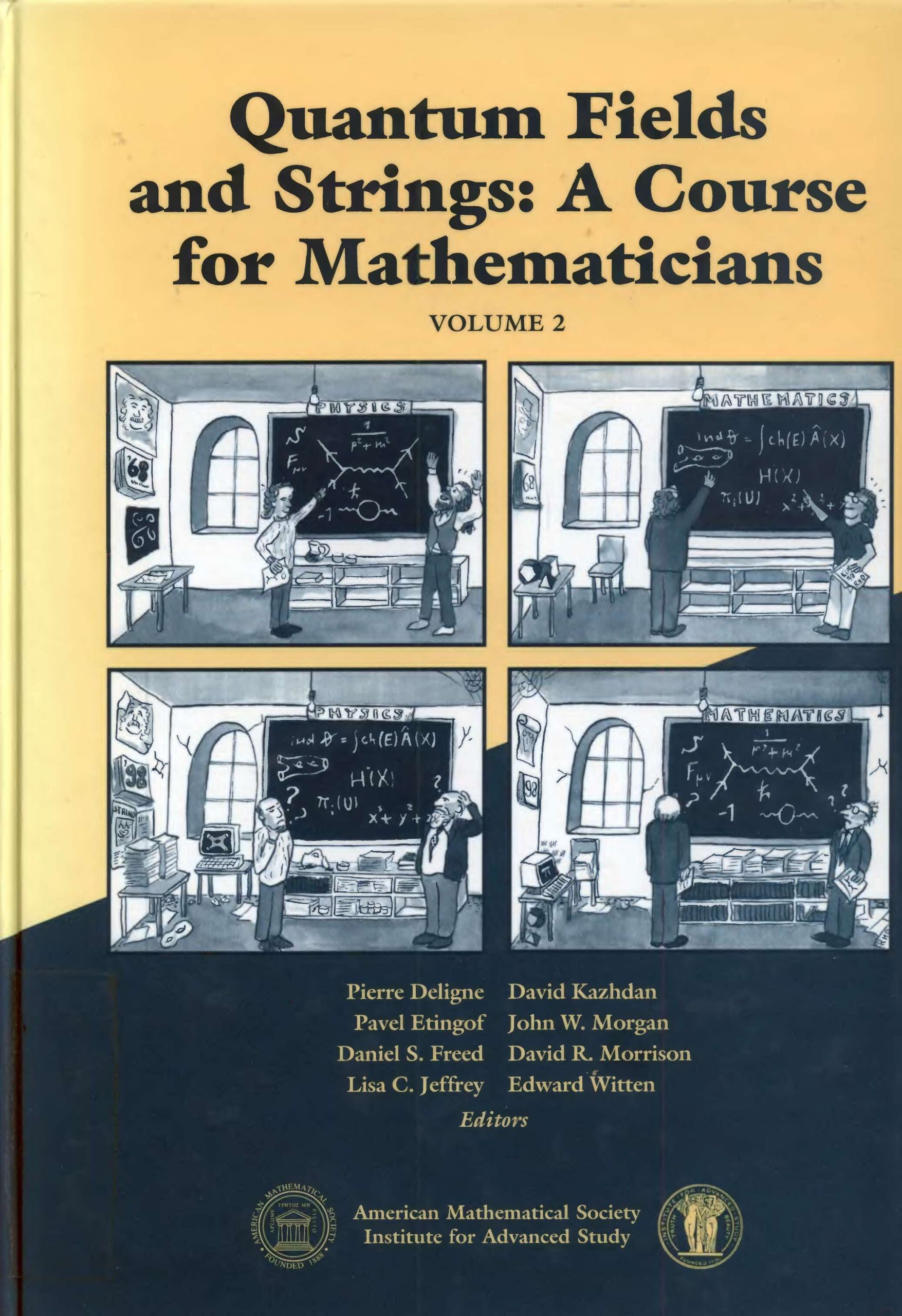
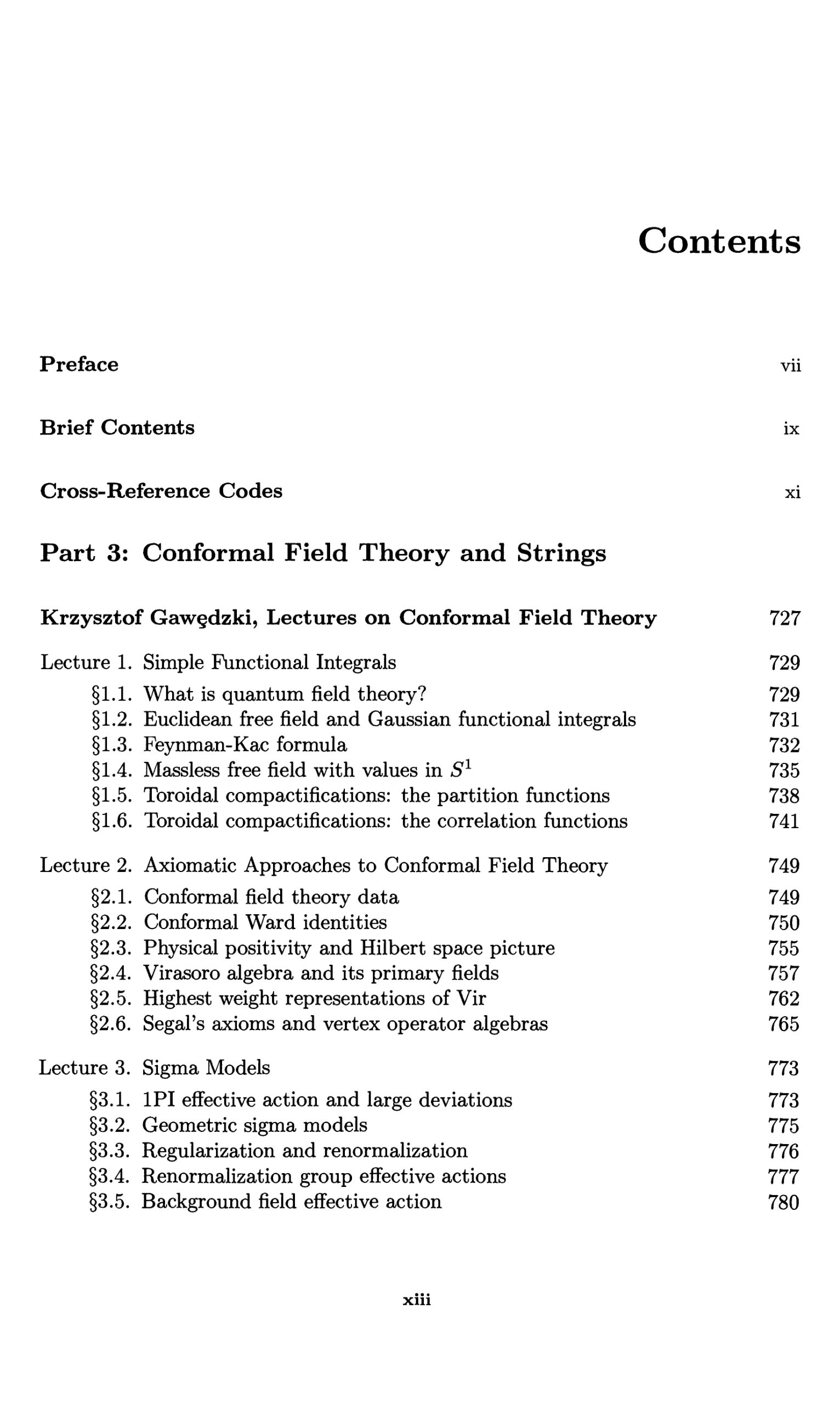

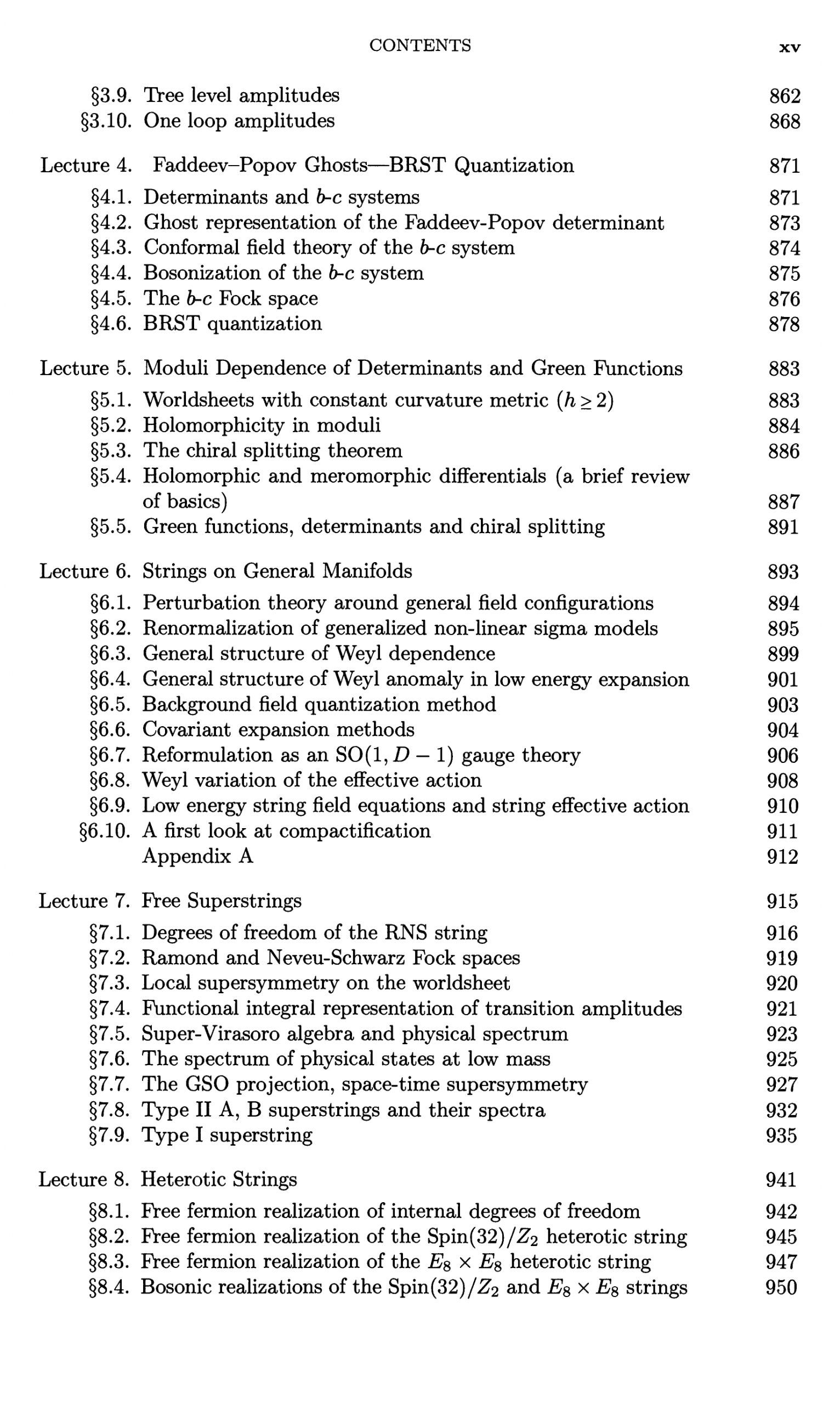
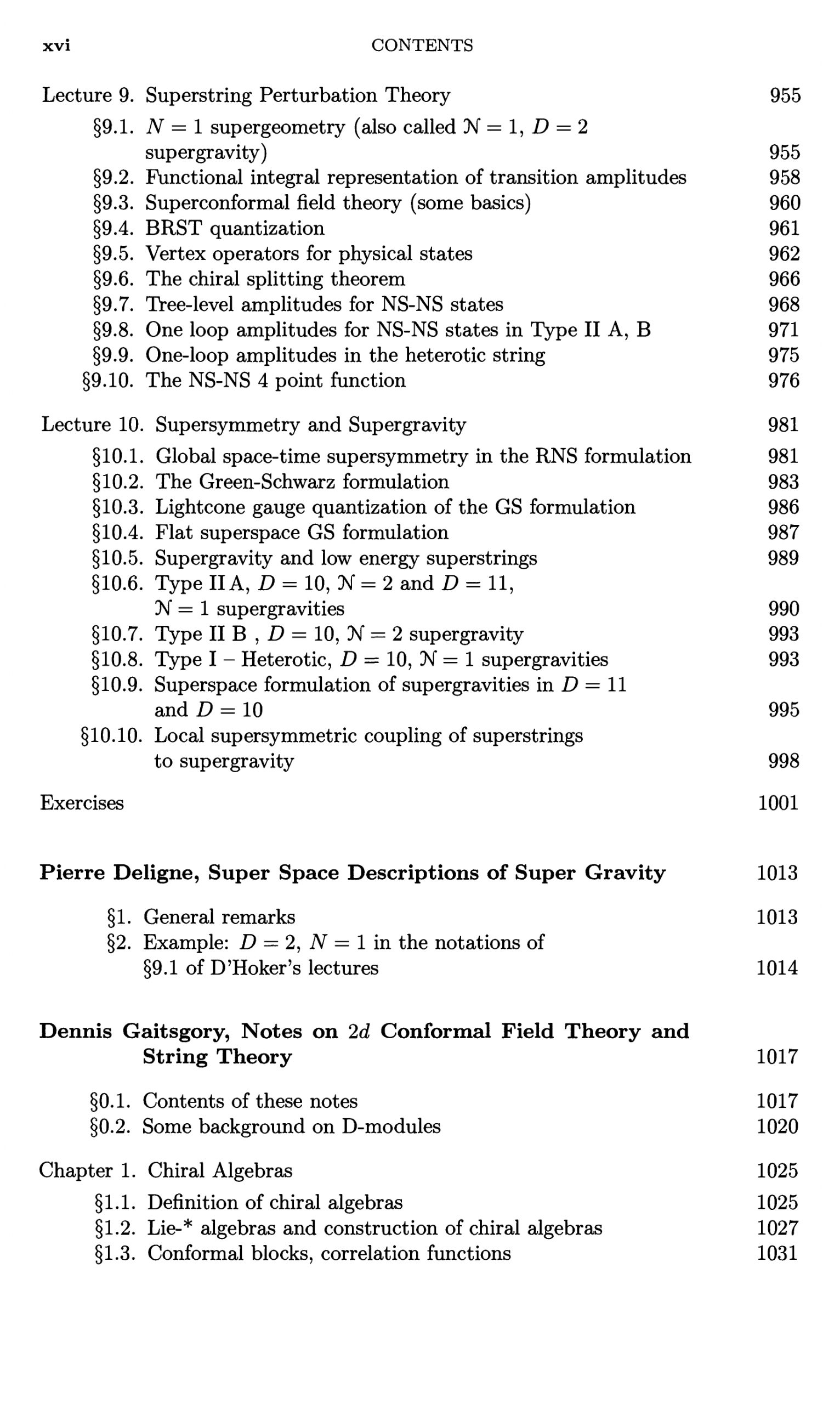
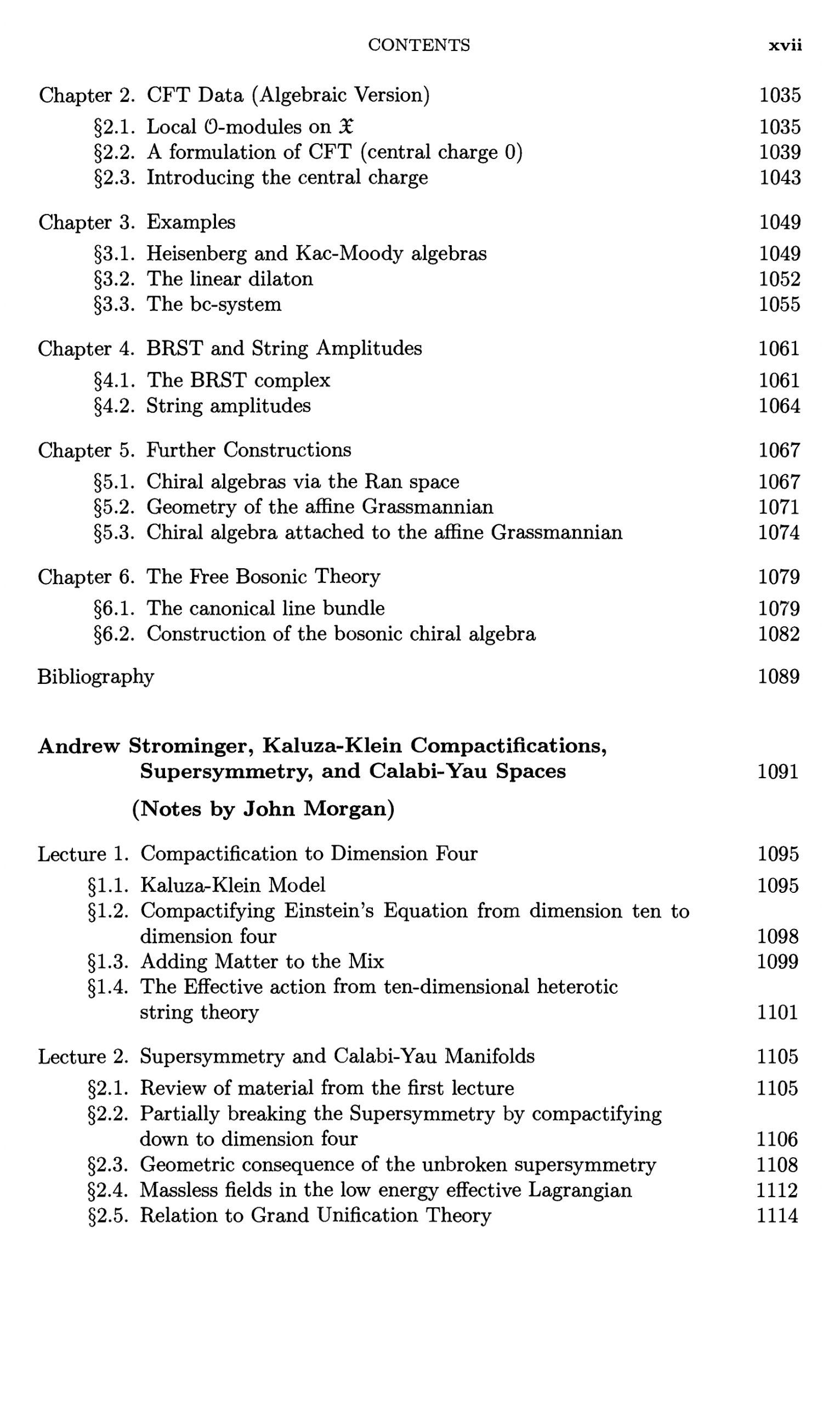
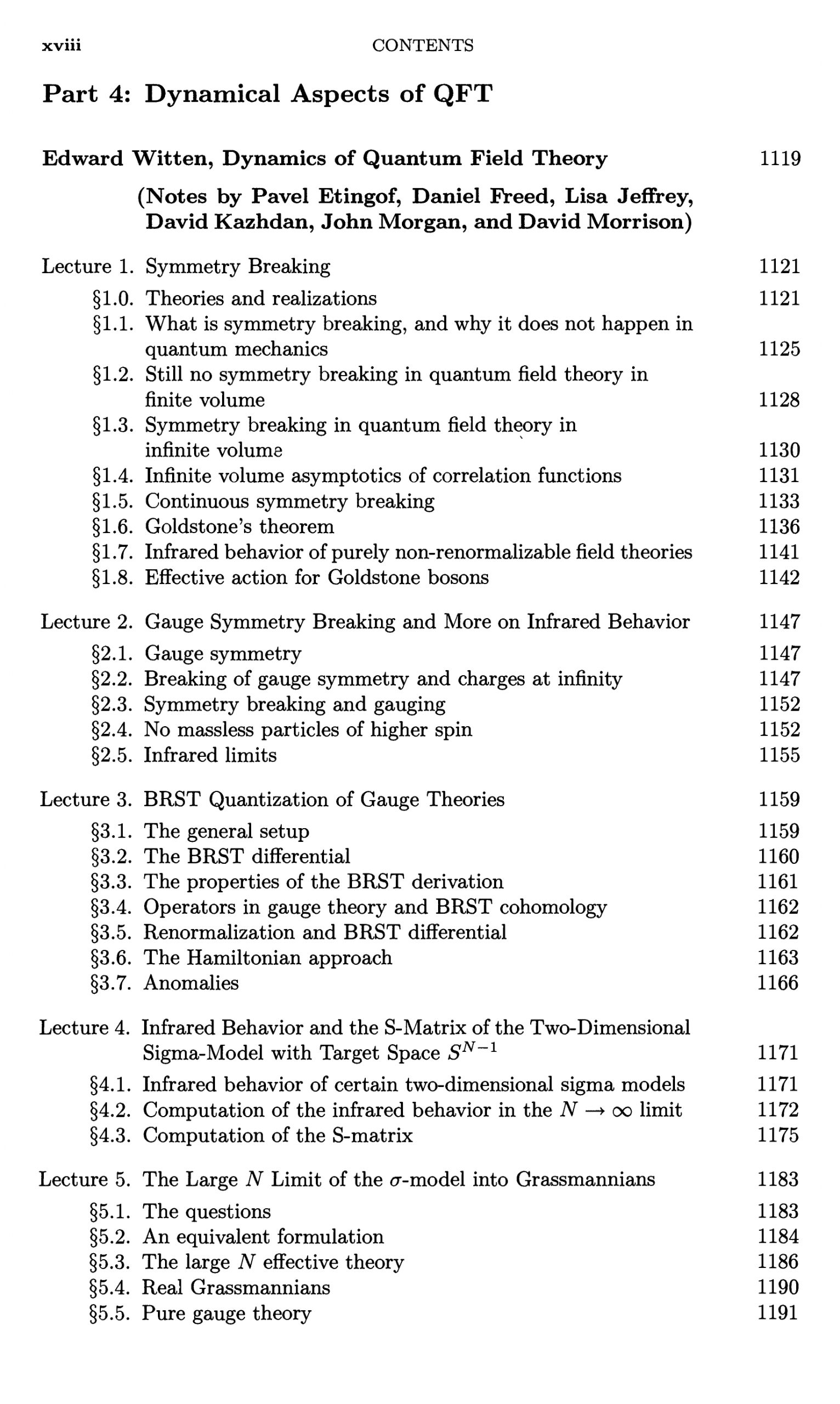
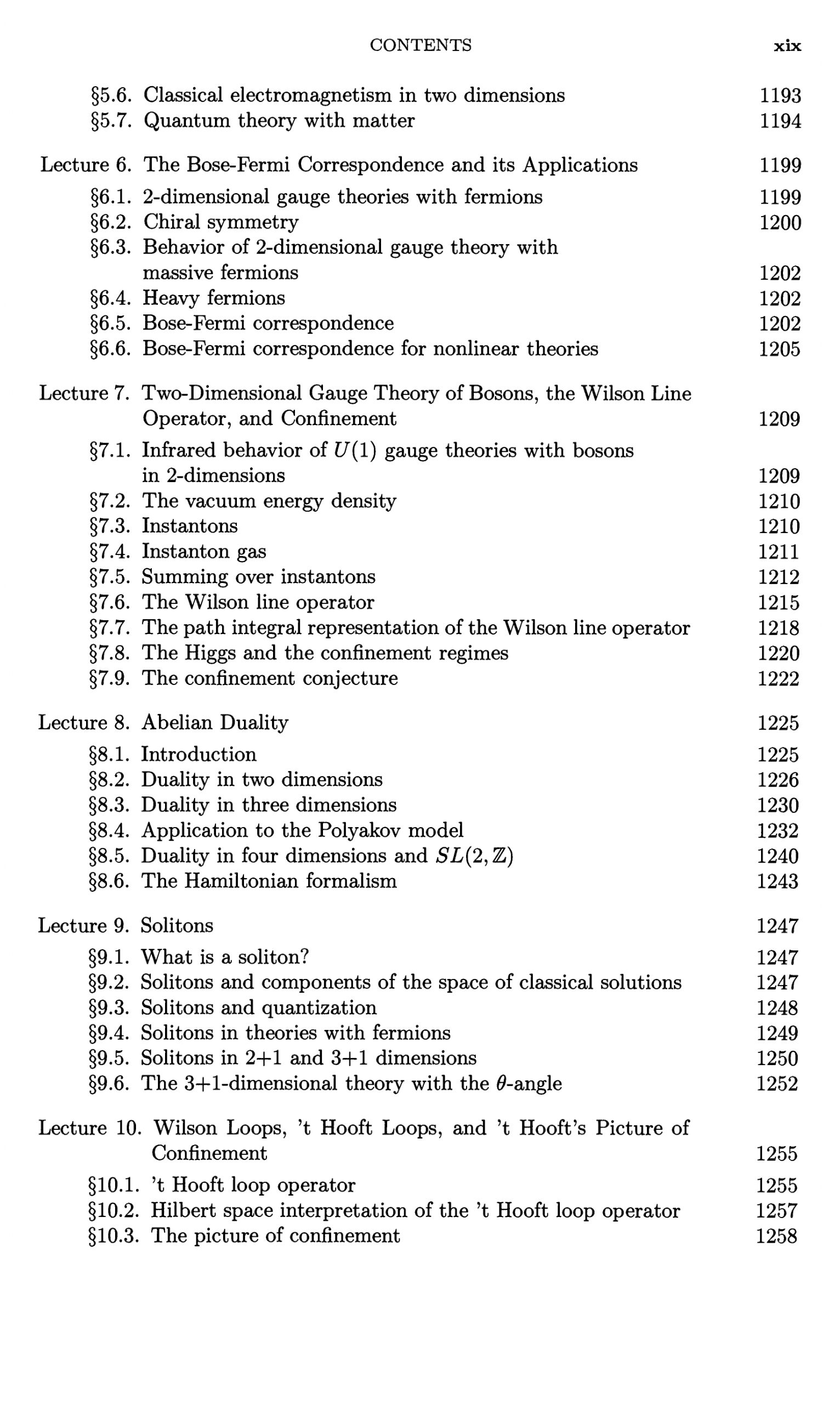
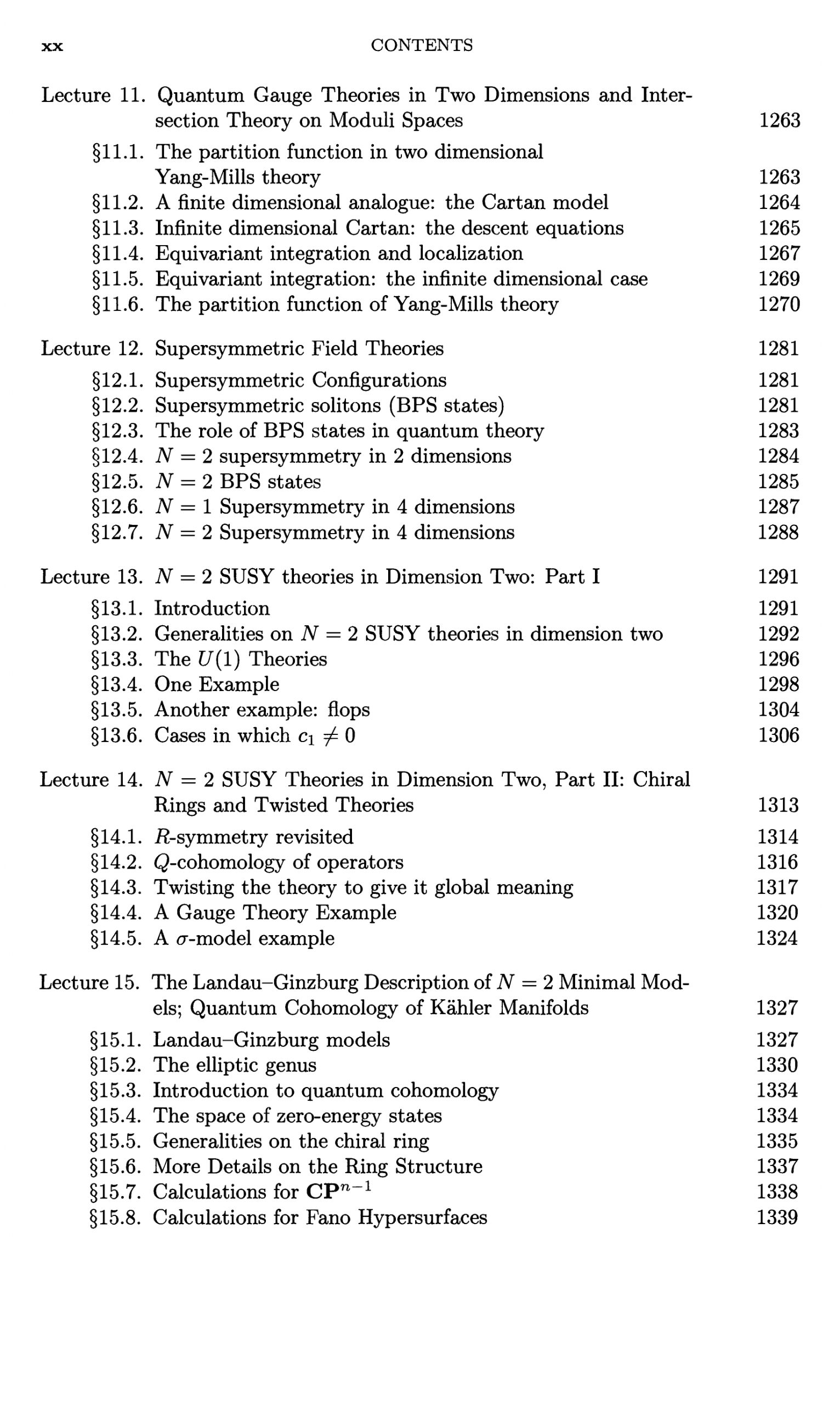
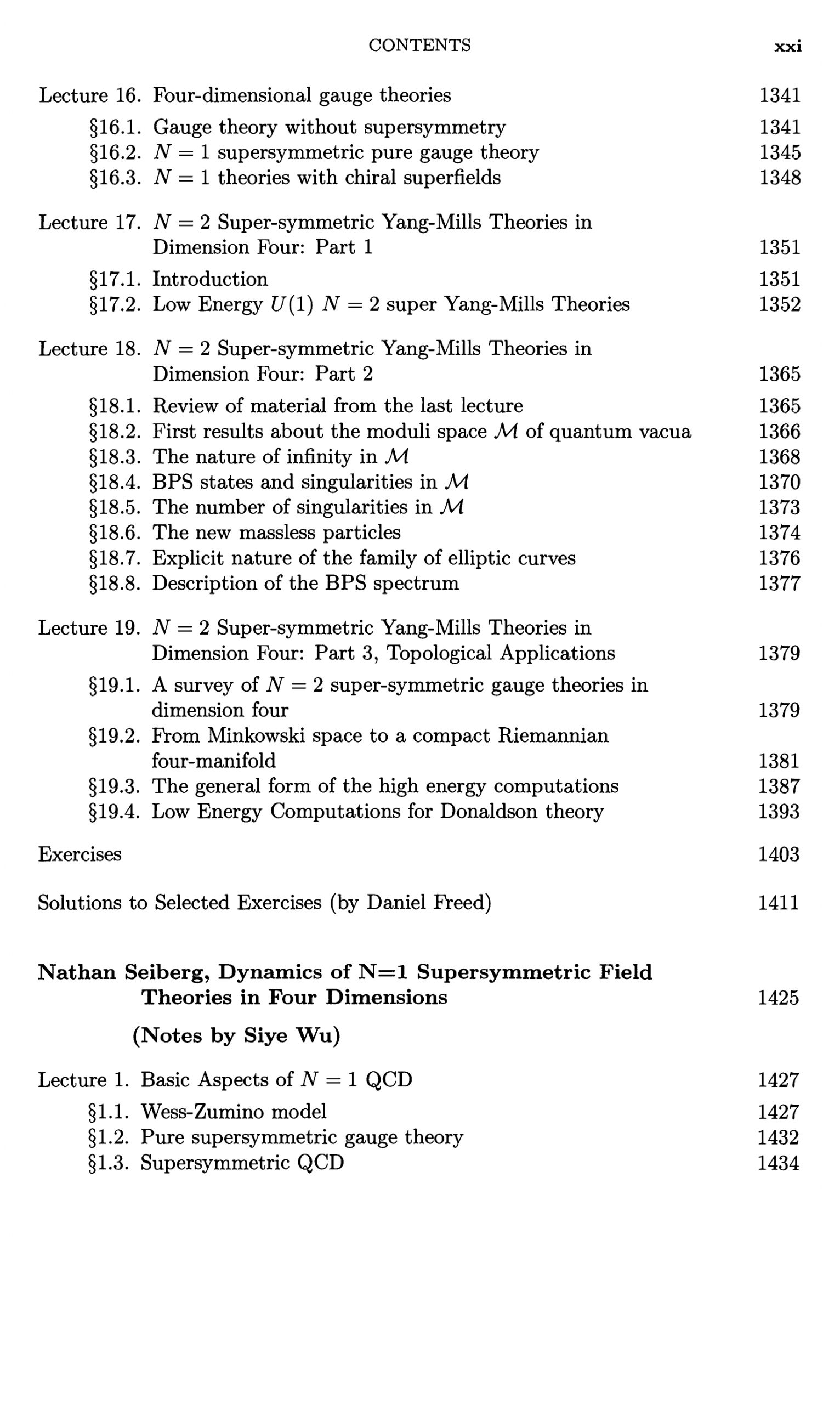
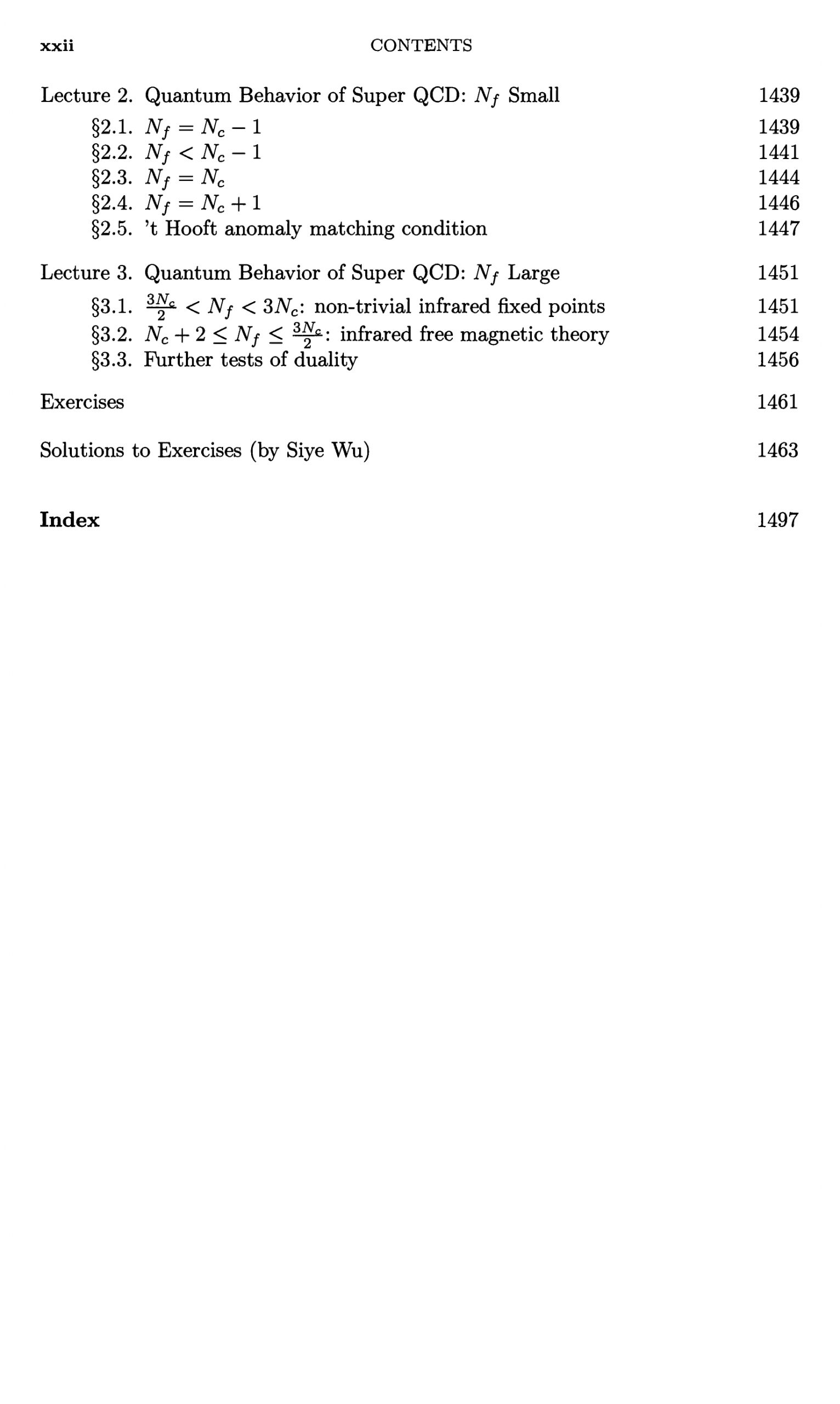
Bryce DeWitt – The Global Approach to Quantum Field Theory
Without the context of the rest of the fast track, this book and its focus on super-numbers will seem peculiar. However we know from studying curvature and Yang-Mills that physically important phenomena are only visible at the global level, such as instantons and solitons. As such, it is important to take a step back into the mathematics and remove any artificialities accidentally introduced via physics to fully understand the situation. This book is particularly interesting because it is a rare instance of solely focusing on these global effects, and the second volume contains a number of special studies that might lead to future discoveries following a comprehensive physical treatment of global QFT.
Traditionally, quantum field theory books introduce the classical Klein-Gordon and Dirac fields and express their solutions in space-time as Fourier transforms of corresponding distributions supported on a hyperbola in the corresponding dual momentum-energy space. This is then quantized with formally introduced creation and annihilation operators, as is hopefully familiar by now. However, this approach proves to be naive on curved space-time, since the Fourier transform doesn’t directly make sense. Formulating the classical fields on space-time does make sense, utilizing the naturally provided differential operators. One then recalls the distribution theory and microlocal analysis approach of Gel’fand and Hörmander earlier and sees that quantization is possible in curved space-time with these tools, this is the corresponding mathematical story to DeWitt’s book. A good introduction is Microlocal Analysis of Quantum Fields on Curved Spacetimes by Christian Gérard
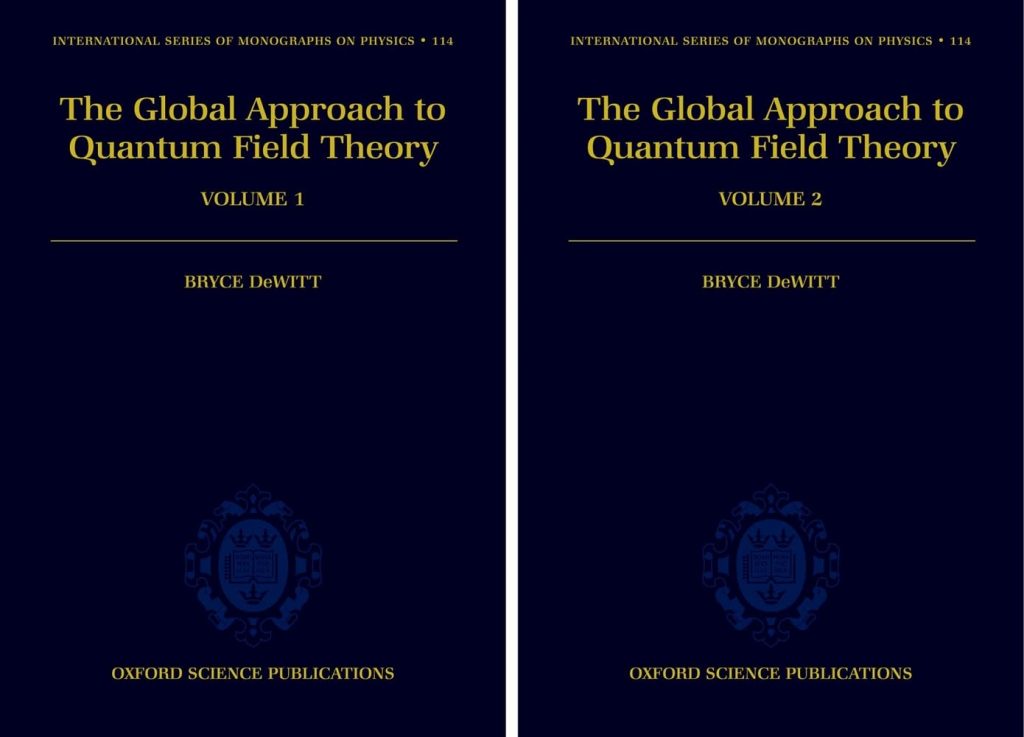
Table of Contents
Volume 1











Volume 2












Isu Vaisman – Differential Forms & Cohomology
By now, the reader has seen hints of categories in Brown’s Topology and Groupoids, Lang’s Algebra, Bott & Tu, and K Theory which are a joint generalization of graphs/partially ordered sets and groups/monoids to codify the transformations internal to and between mathematical objects like topological spaces, vector bundles, modules, and groups. This text is unusual in that it doesn’t focus on just geometry, it builds up the general theory of smooth manifolds, foliated manifolds, and complex manifolds from the bare basics of axiomatic Von Neumann–Bernays–Gödel set theory and category theory. We have been careful to not include redundant texts, but the sky-high view of the subject that this text presents, and the unification with formalism used in algebraic topology and algebraic geometry make it a powerful read when the reader is ready. Historical sheaf terminology is used, a simple dictionary comparing it to modern terminology is here.
Sheaves appear as early as in Ahlfors’ complex analysis to encode holomorphic structure in spaces of functions over a given topological space, implicitly in the definition of a differentiable structure in Sternberg, and again in Bott and Tu to encode the interaction of open covers with cohomology and to prove De Rham’s theorem. They also are used essentially in algebraic geometry, to describe how the type of ring local coordinate functions are elements of varies from neighborhood to neighborhood and with their own derived functor definition of cohomology.
This interaction between sheaves and concrete computations via open covers on one side and to encode types of geometric structure are the core theme of this book, leading to the construction of Cech cohomology and fundamental theorems on the structure of Riemannian, foliated, and complex manifolds. Associated characteristic classes to these structures interact with physics, particularly in the guise of “topological quantum numbers” for gauge theory. In a spiritual successor to Vaisman’s book (Loop Spaces, Characteristic Classes and Geometric Quantization by Jean-Luc Brylinski) extends this theory to higher degree cohomology and stacks in order to discuss geometric structures on infinite dimensional phase spaces and Dirac charge quantization abstractly.

Table of Contents


Arthur Besse – Einstein Manifolds
This is a book primarily on the interpretation of intrinsic curvature, its importance in the dynamics of general relativity being apparent, and a different extrinsic/auxiliary sort of curvature discussed in Atiyah’s Yang-Mills Fields text also driving the dynamics of the other fundamental forces. The GR-analog of instantons are the main object of this book. There is some review in the beginning, but considerable background in Riemannian geometry, PDEs, and relativity is required.

Table of Contents






It is important to understand that despite the apparent difficulty of these texts, they motivate one another and with a minimum of arithmetic skill, the symbolic methods of calculus, linear algebra, and an interest to work things out on paper are needed to succeed.
Another list, the first two texts of which review these basics can be found here.
The reproduction of materials in this post constitutes fair use.